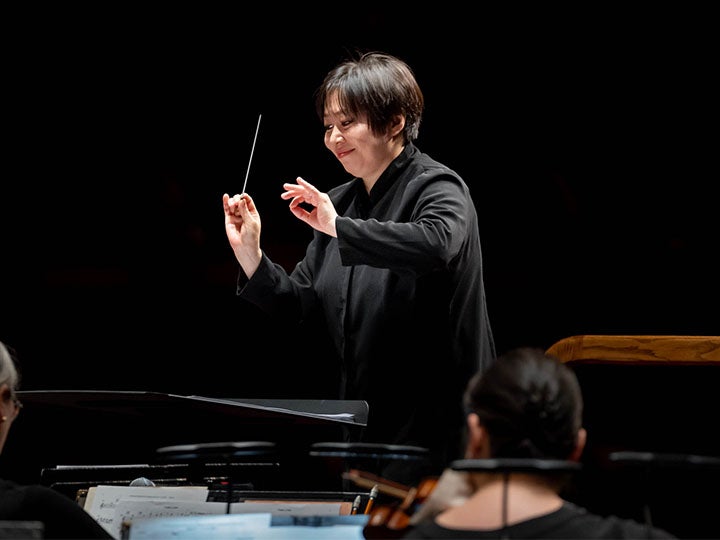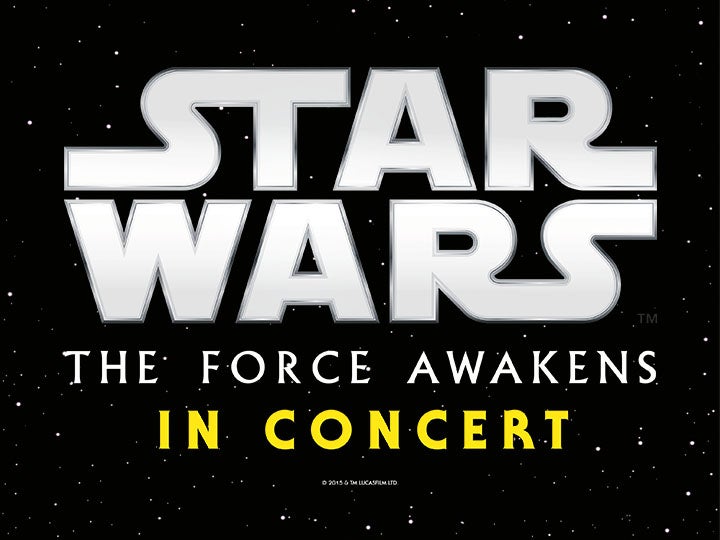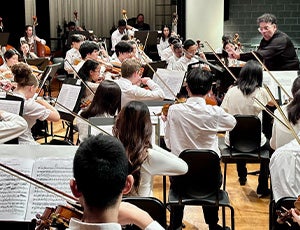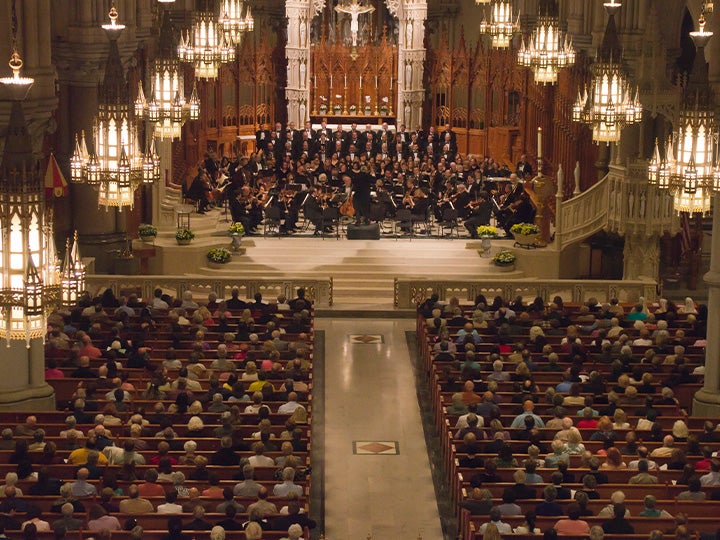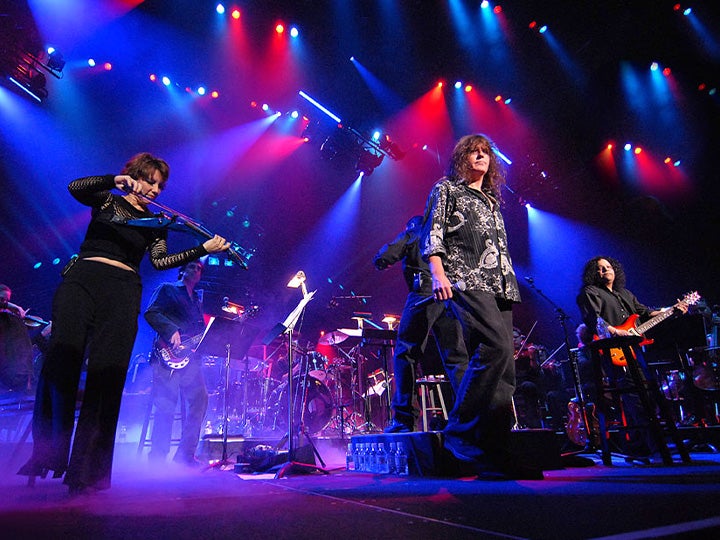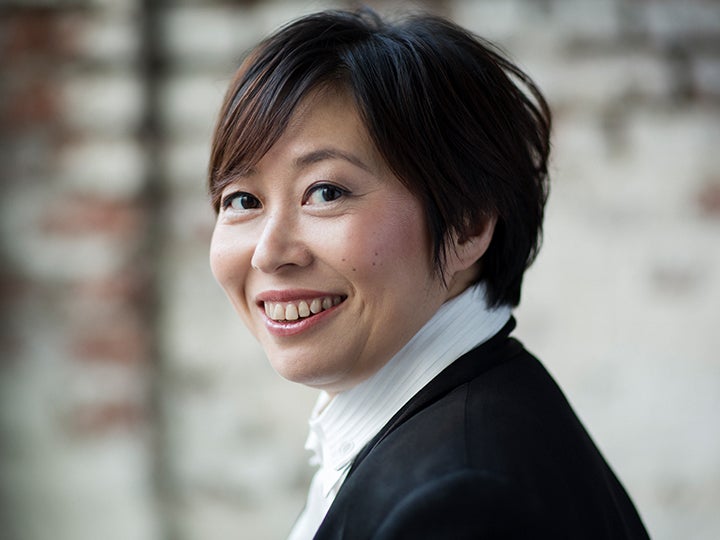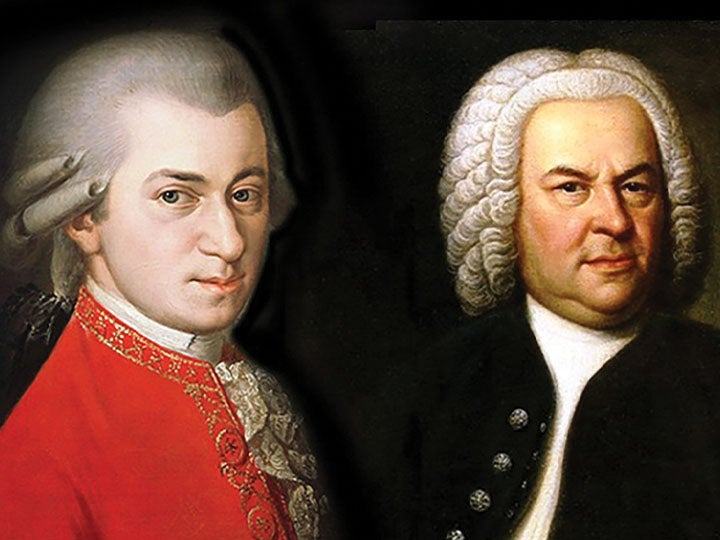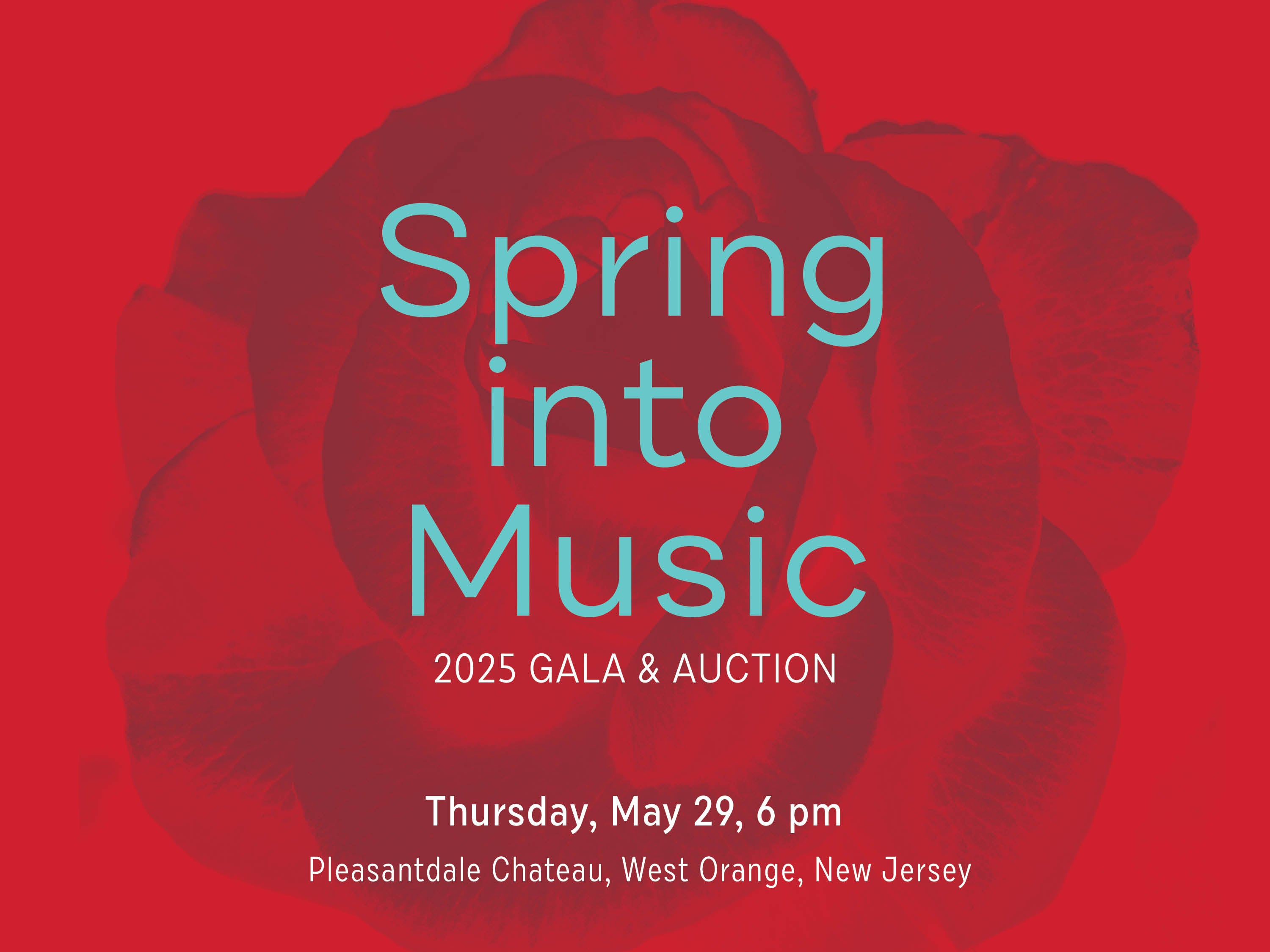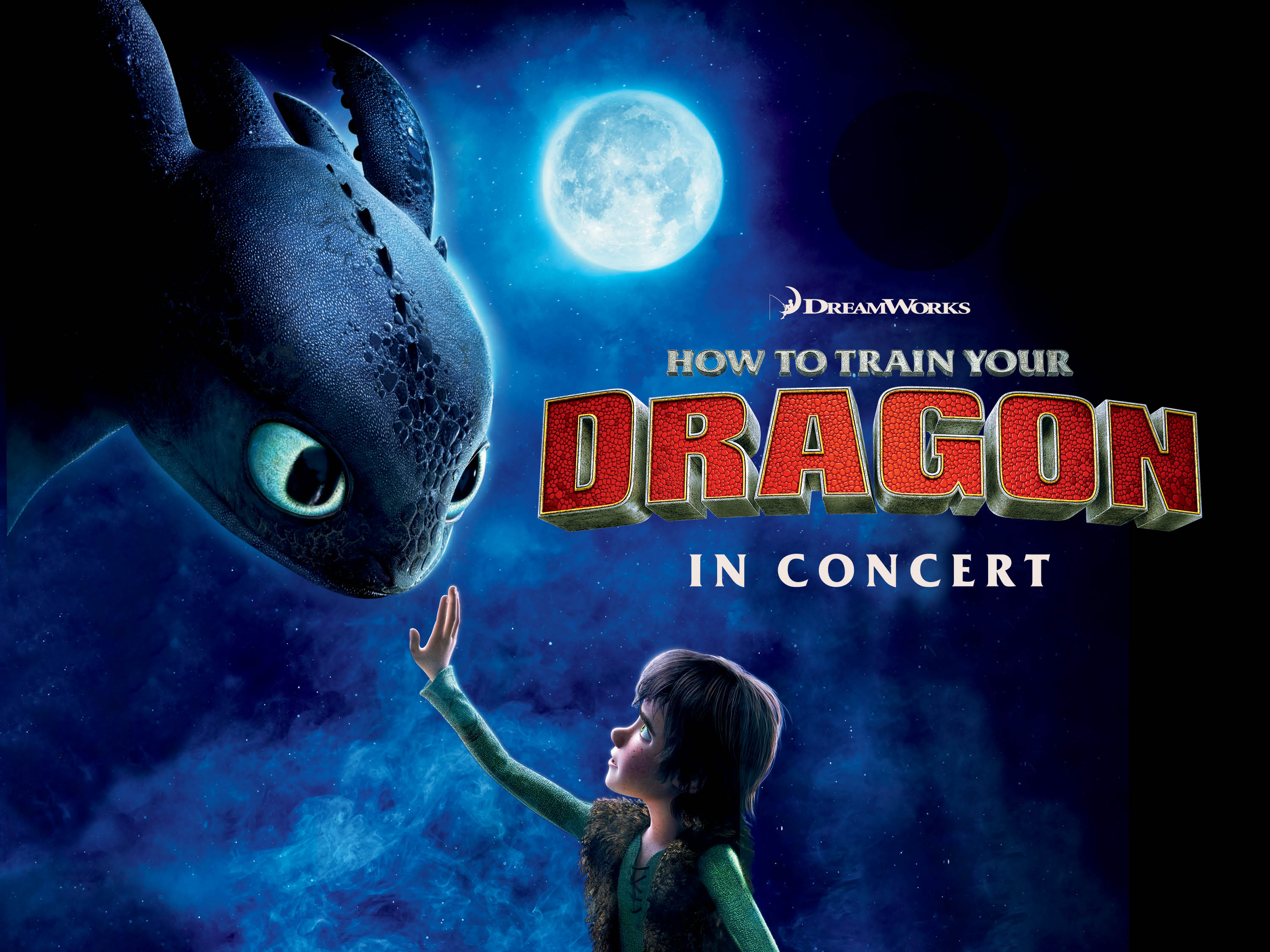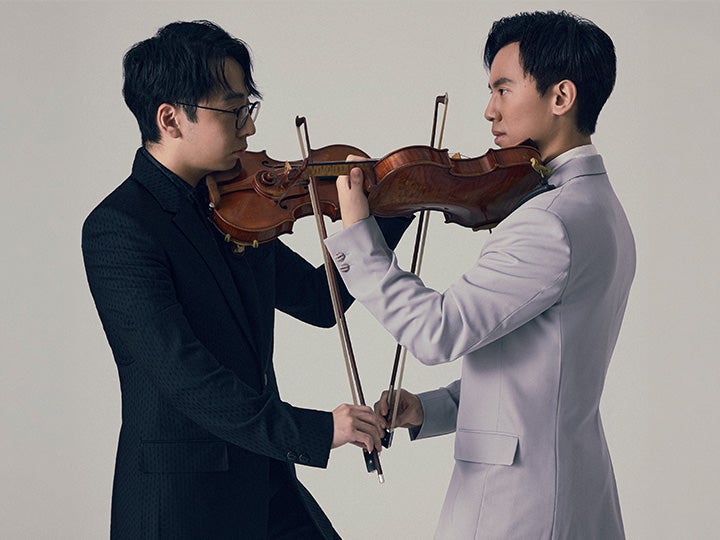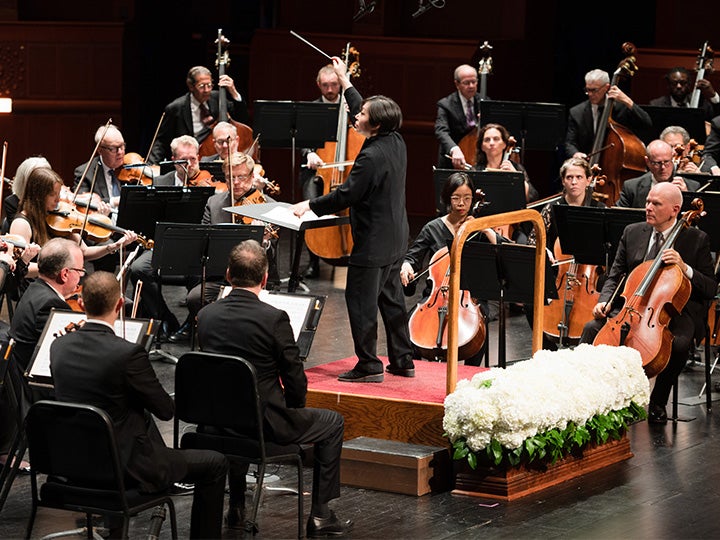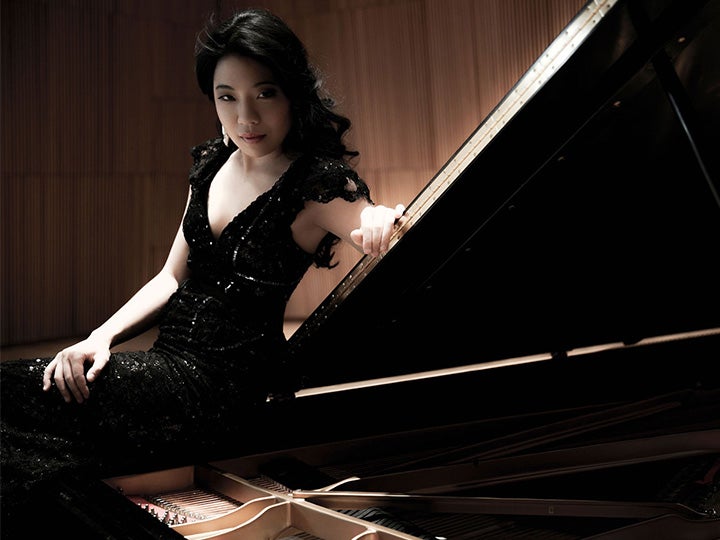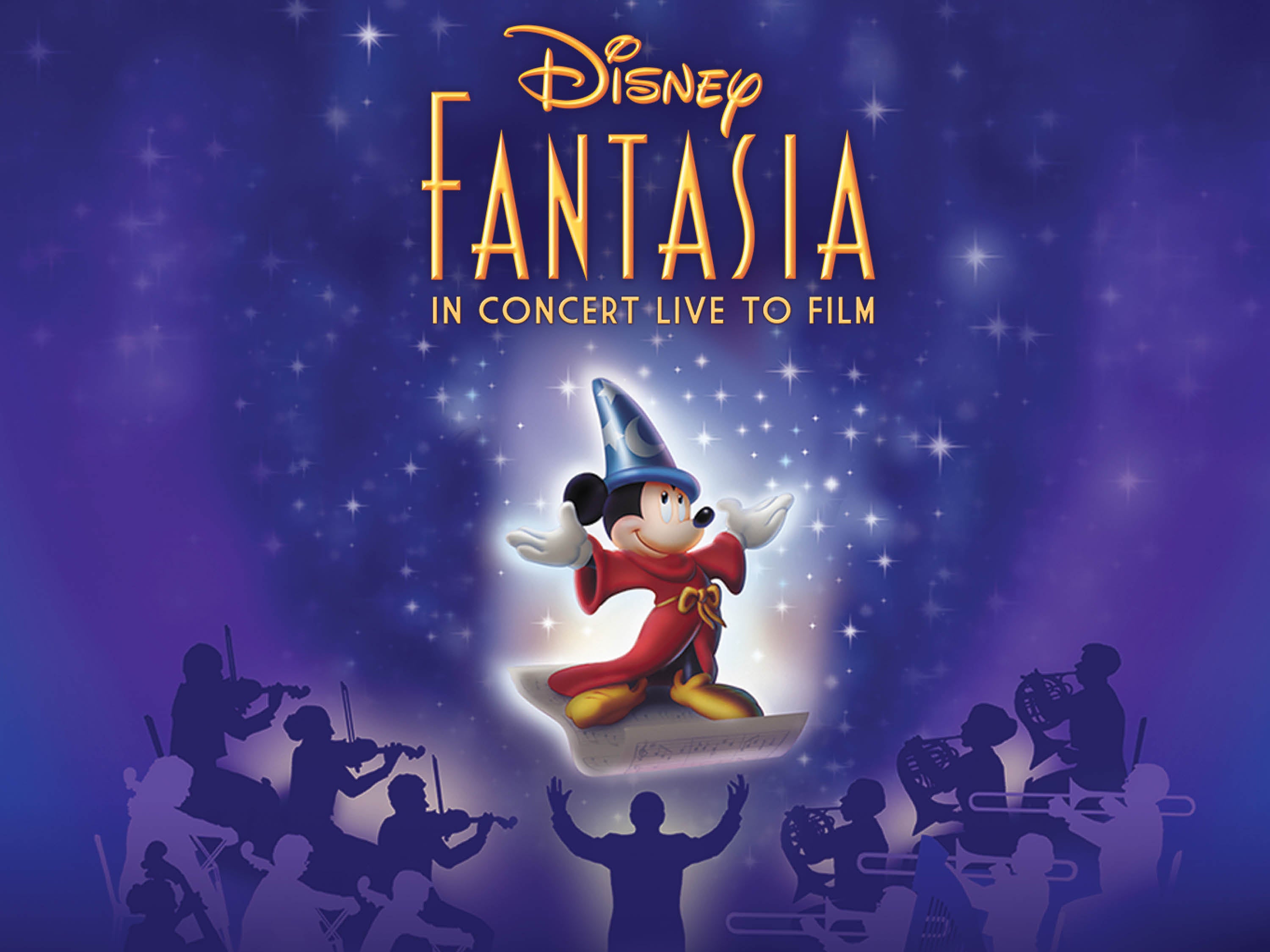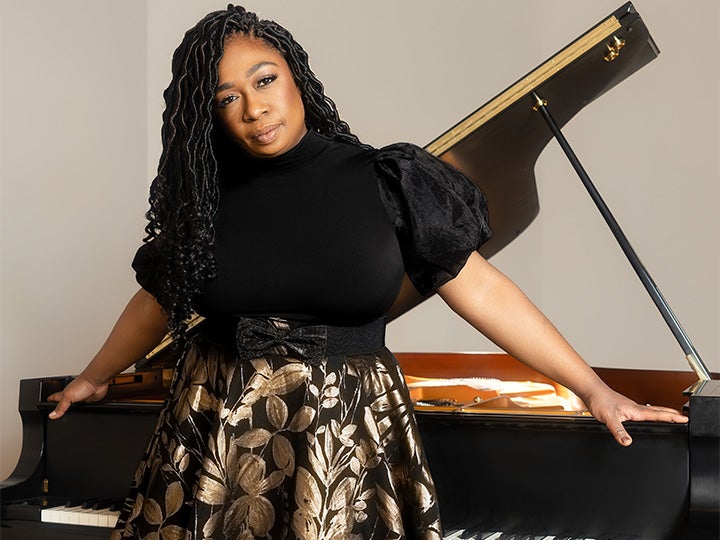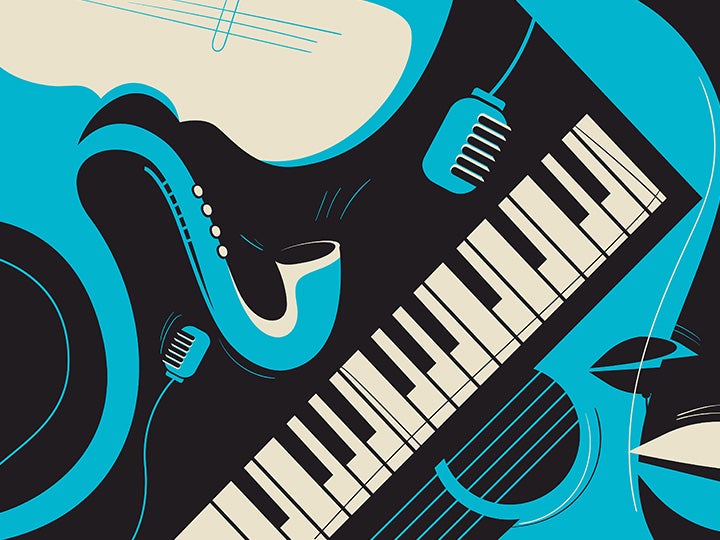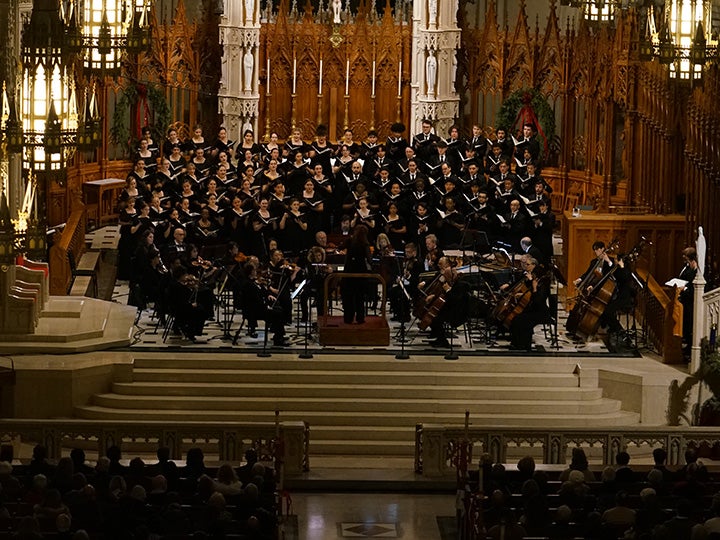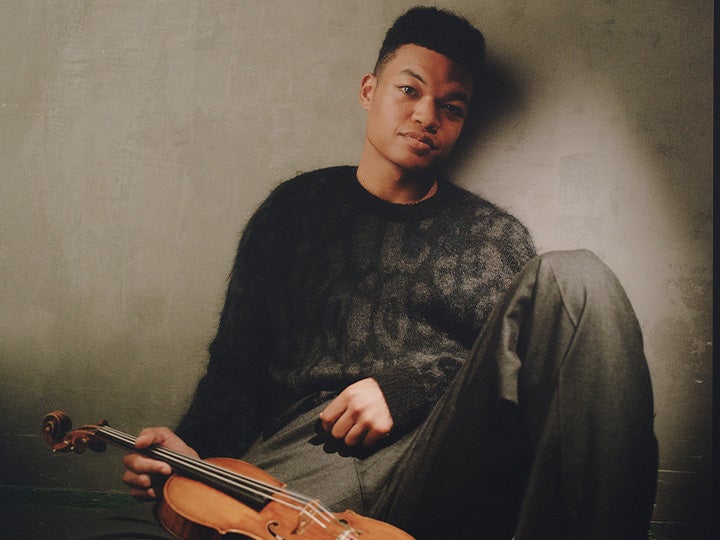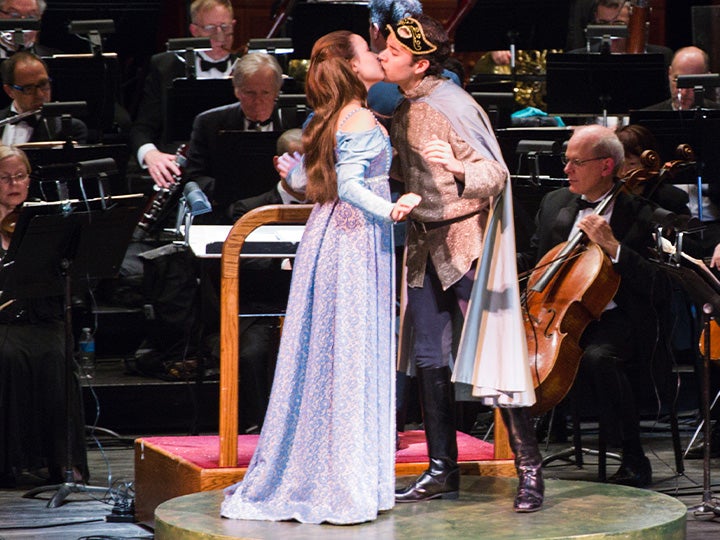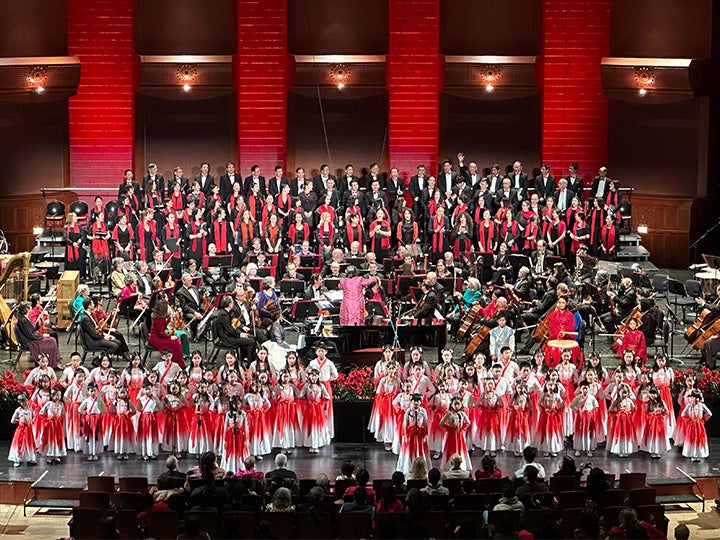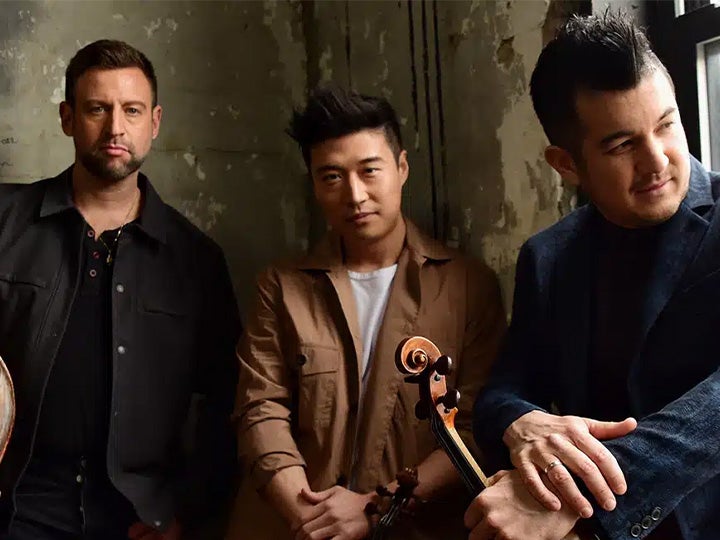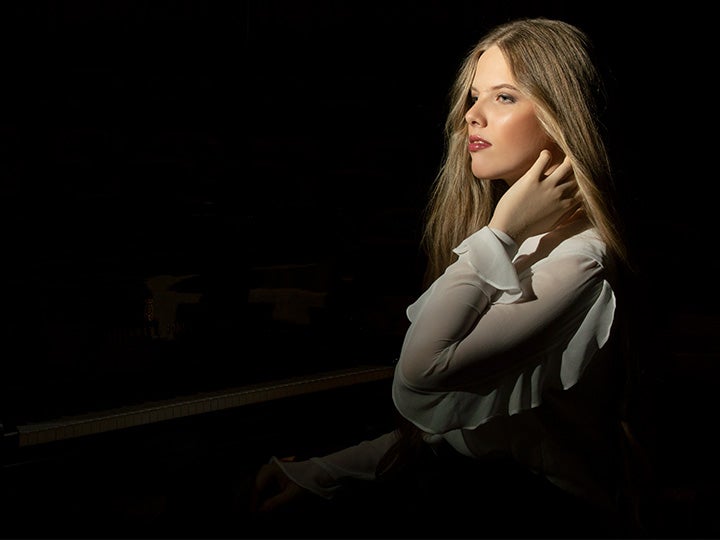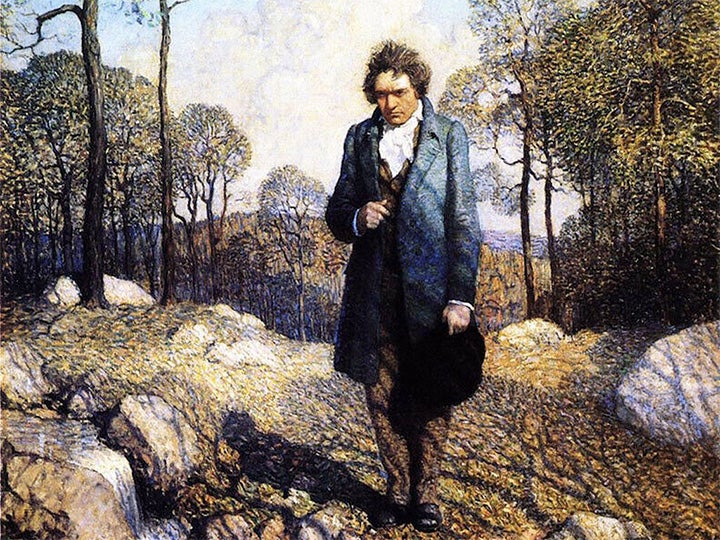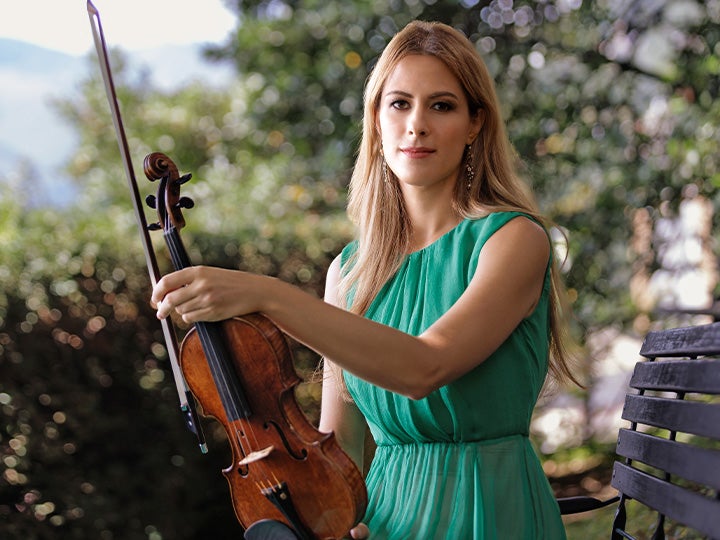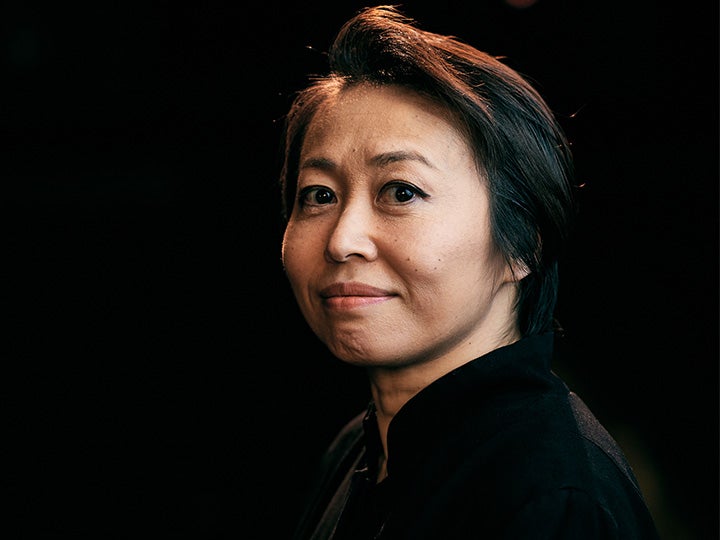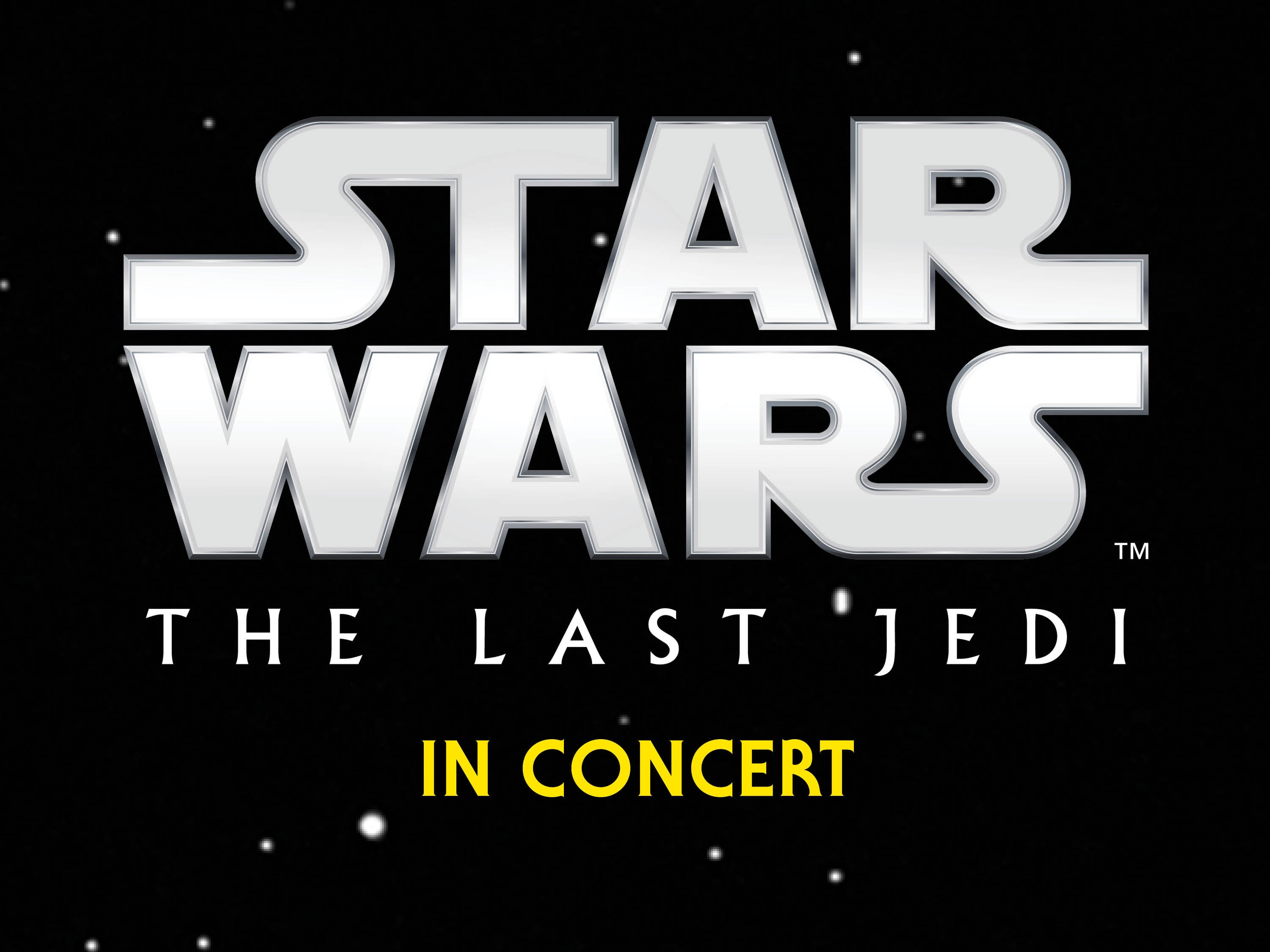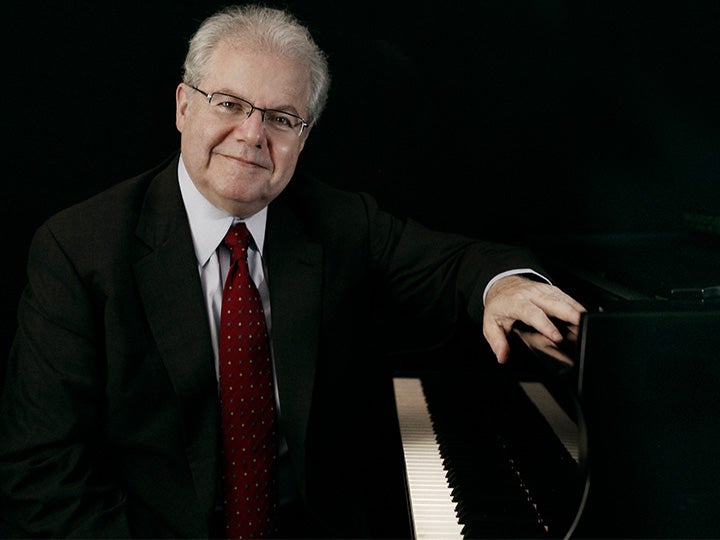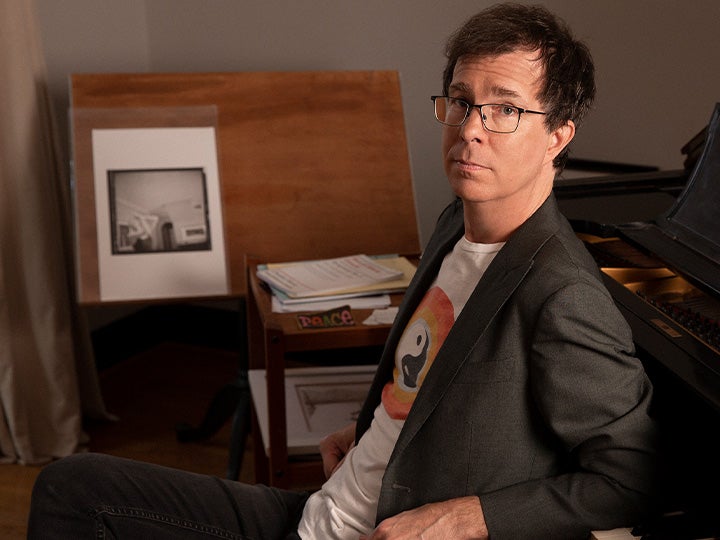Beethoven’s Ninth Symphony with Xian Zhang
New Jersey Symphony Classical
Xian Zhang conductor
Gregory D. McDaniel conductor
Steven Banks saxophone
Felicia Moore soprano
Kelley O’Connor mezzo-soprano
Issachah Savage tenor
Reginald Smith Jr. baritone
Montclair State University Chorale | Heather J. Buchanan, director
New Jersey Symphony
- Pytor Ilyich Tchaikovsky Polonaise from Eugene Onegin
A lavish ball scene, the dashing hero and heroine twirling in splendor—a fun, festive dance lifted from Tchaikovsky’s opera.
- Billy Childs Diaspora
Inspired by Maya Angelou and other poets, Childs’ new concerto was written for the amazing Steven Banks, who says the music “follows the trajectory of the Black experience from Africa before slave trade to now, going forward in hope.”
- Ludwig van Beethoven Symphony No. 9, “Choral”
The sheer volcanic power of Beethoven’s music makes the Ninth’s message soar. “Brotherhood! Joy!”—our world needs these clarion calls now more than ever.
Performed in Newark and New Brunswick
Beethoven’s Ninth Symphony with Xian Zhang
New Jersey Symphony Classical
Xian Zhang conductor
Gregory D. McDaniel conductor
Steven Banks saxophone
Felicia Moore soprano
Kelley O’Connor mezzo-soprano
Issachah Savage tenor
Reginald Smith Jr. baritone
Montclair State University Chorale | Heather J. Buchanan, director
New Jersey Symphony
- Pytor Ilyich Tchaikovsky Polonaise from Eugene Onegin
A lavish ball scene, the dashing hero and heroine twirling in splendor—a fun, festive dance lifted from Tchaikovsky’s opera.
- Billy Childs Diaspora
Inspired by Maya Angelou and other poets, Childs’ new concerto was written for the amazing Steven Banks, who says the music “follows the trajectory of the Black experience from Africa before slave trade to now, going forward in hope.”
- Ludwig van Beethoven Symphony No. 9, “Choral”
The sheer volcanic power of Beethoven’s music makes the Ninth’s message soar. “Brotherhood! Joy!”—our world needs these clarion calls now more than ever.
Performed in Newark and New Brunswick
Beethoven’s Ninth Symphony with Xian Zhang
New Jersey Symphony Classical
Xian Zhang conductor
Gregory D. McDaniel conductor
Steven Banks saxophone
Felicia Moore soprano
Kelley O’Connor mezzo-soprano
Issachah Savage tenor
Reginald Smith Jr. baritone
Montclair State University Chorale | Heather J. Buchanan, director
New Jersey Symphony
- Pytor Ilyich Tchaikovsky Polonaise from Eugene Onegin
A lavish ball scene, the dashing hero and heroine twirling in splendor—a fun, festive dance lifted from Tchaikovsky’s opera.
- Billy Childs Diaspora
Inspired by Maya Angelou and other poets, Childs’ new concerto was written for the amazing Steven Banks, who says the music “follows the trajectory of the Black experience from Africa before slave trade to now, going forward in hope.”
- Ludwig van Beethoven Symphony No. 9, “Choral”
The sheer volcanic power of Beethoven’s music makes the Ninth’s message soar. “Brotherhood! Joy!”—our world needs these clarion calls now more than ever.
Performed in Newark and New Brunswick
Beethoven’s Ninth Symphony with Xian Zhang
New Jersey Symphony Classical
Xian Zhang conductor
Gregory D. McDaniel conductor
Steven Banks saxophone
Felicia Moore soprano
Kelley O’Connor mezzo-soprano
Issachah Savage tenor
Reginald Smith Jr. baritone
Montclair State University Chorale | Heather J. Buchanan, director
New Jersey Symphony
- Pytor Ilyich Tchaikovsky Polonaise from Eugene Onegin
A lavish ball scene, the dashing hero and heroine twirling in splendor—a fun, festive dance lifted from Tchaikovsky’s opera.
- Billy Childs Diaspora
Inspired by Maya Angelou and other poets, Childs’ new concerto was written for the amazing Steven Banks, who says the music “follows the trajectory of the Black experience from Africa before slave trade to now, going forward in hope.”
- Ludwig van Beethoven Symphony No. 9, “Choral”
The sheer volcanic power of Beethoven’s music makes the Ninth’s message soar. “Brotherhood! Joy!”—our world needs these clarion calls now more than ever.
Performed in Newark and New Brunswick
Star Wars: The Force Awakens in Concert
New Jersey Symphony at the Movies
Constantine Kitsopoulos conductor
New Jersey Symphony
Thirty years after the defeat of the Empire, Luke Skywalker has vanished, and a new threat has risen: The First Order, led by the mysterious Supreme Leader Snoke and his enforcer, Kylo Ren. General Leia Organa’s military force, the Resistance—and unlikely heroes brought together by fate—are the galaxy’s only hope. Experience the complete film with the New Jersey Symphony performing John Williams’ thrilling score live.
Performed in Red Bank, Morristown, Newark and New Brunswick
Star Wars: The Force Awakens in Concert
New Jersey Symphony at the Movies
Constantine Kitsopoulos conductor
New Jersey Symphony
Thirty years after the defeat of the Empire, Luke Skywalker has vanished, and a new threat has risen: The First Order, led by the mysterious Supreme Leader Snoke and his enforcer, Kylo Ren. General Leia Organa’s military force, the Resistance—and unlikely heroes brought together by fate—are the galaxy’s only hope. Experience the complete film with the New Jersey Symphony performing John Williams’ thrilling score live.
Performed in Red Bank, Morristown, Newark and New Brunswick
Star Wars: The Force Awakens in Concert
New Jersey Symphony at the Movies
Constantine Kitsopoulos conductor
New Jersey Symphony
Thirty years after the defeat of the Empire, Luke Skywalker has vanished, and a new threat has risen: The First Order, led by the mysterious Supreme Leader Snoke and his enforcer, Kylo Ren. General Leia Organa’s military force, the Resistance—and unlikely heroes brought together by fate—are the galaxy’s only hope. Experience the complete film with the New Jersey Symphony performing John Williams’ thrilling score live.
Performed in Red Bank, Morristown, Newark and New Brunswick
Star Wars: The Force Awakens in Concert
New Jersey Symphony at the Movies
Constantine Kitsopoulos conductor
New Jersey Symphony
Thirty years after the defeat of the Empire, Luke Skywalker has vanished, and a new threat has risen: The First Order, led by the mysterious Supreme Leader Snoke and his enforcer, Kylo Ren. General Leia Organa’s military force, the Resistance—and unlikely heroes brought together by fate—are the galaxy’s only hope. Experience the complete film with the New Jersey Symphony performing John Williams’ thrilling score live.
Performed in Red Bank, Morristown, Newark and New Brunswick
Youth Orchestra Spring Concert
Two performances in one day! | Youth Orchestra Showcase
Diego García artistic director, The Anna P. Drago Chair
Terrence Thornhill associate conductor & curriculum specialist
New Jersey Symphony Youth Orchestra, The Resident Youth Orchestra of the John J. Cali School of Music at Montclair State University
The New Jersey Symphony Youth Orchestra will showcase 300 talented young musicians across two performances as part of their annual Spring Concert on Sunday, April 27 in Newark. Experience vibrant performances and celebrate the achievements of the 2024–25 season, including a special tribute to the graduating seniors.
Performed in Newark
Youth Orchestra Spring Concert
Two performances in one day! | Youth Orchestra Showcase
Diego García artistic director, The Anna P. Drago Chair
Terrence Thornhill associate conductor & curriculum specialist
New Jersey Symphony Youth Orchestra, The Resident Youth Orchestra of the John J. Cali School of Music at Montclair State University
The New Jersey Symphony Youth Orchestra will showcase 300 talented young musicians across two performances as part of their annual Spring Concert on Sunday, April 27 in Newark. Experience vibrant performances and celebrate the achievements of the 2024–25 season, including a special tribute to the graduating seniors.
Performed in Newark
Haydn’s Creation
New Jersey Symphony at the Cathedral
John J. Miller conductor
Lorraine Ernest soprano
Theodore Chletsos tenor
Jorge Ocasio bass-baritone
The Archdiocesan Festival Choir
The Cathedral Choir
New Jersey Symphony
The Cathedral Basilica of the Sacred Heart in Newark, NJ invites all to experience the music of Franz Joseph Haydn’s The Creation, featuring The Archdiocesan Festival Choir, The Cathedral Choir, vocal soloists and the New Jersey Symphony with John J. Miller conducting.
Performed in Newark
The Music of Led Zeppelin
Featuring hits like “Kashmir,” “Black Dog,” “Stairway to Heaven” and more!
Brent Havens conductor & arranger
Windborne Music Group
Justin Sargent vocalist
New Jersey Symphony
The New Jersey Symphony and Windborne Music Group bridge the gulf between classical music and rock n’ roll to present The Music of Led Zeppelin, celebrating the best of the legendary classic rock group. Amplified with full-on guitars and screaming vocals, sing and dance along as Led Zeppelin’s “sheer blast and power” is put on full display riff for riff with new musical colors. Timeless hits like “Kashmir,” “Black Dog,” “Stairway to Heaven” and more will get you on your feet in this special concert you don’t want to miss!
Performed in Englewood and New Brunswick
The Music of Led Zeppelin
Featuring hits like “Kashmir,” “Black Dog,” “Stairway to Heaven” and more!
Brent Havens conductor & arranger
Windborne Music Group
Justin Sargent vocalist
New Jersey Symphony
The New Jersey Symphony and Windborne Music Group bridge the gulf between classical music and rock n’ roll to present The Music of Led Zeppelin, celebrating the best of the legendary classic rock group. Amplified with full-on guitars and screaming vocals, sing and dance along as Led Zeppelin’s “sheer blast and power” is put on full display riff for riff with new musical colors. Timeless hits like “Kashmir,” “Black Dog,” “Stairway to Heaven” and more will get you on your feet in this special concert you don’t want to miss!
Performed in Englewood and New Brunswick
Xian Conducts Mozart
New Jersey Symphony musicians take the spotlight!
Xian Zhang conductor
Eric Wyrick violin
Francine Storck violin
New Jersey Symphony
- Wolfgang Amadeus Mozart Eine kleine Nachtmusik
Mozart may have tossed this off for a Viennese party one evening, but there is no piece more charming and beguiling than his “a little night music.”
- Johann Sebastian Bach Double Concerto for Two Violins
The spotlight’s on our two superstar principal violins, Eric Wyrick and Francine Storck, in perhaps the most beautiful duet ever created.
- Michael Abels Delights and Dances
Delight in this imaginative, bluesy work for solo string quartet and string orchestra, with New Jersey Symphony’s own musicians taking the spotlight in a series of captivating solos.
- Wolfgang Amadeus Mozart Symphony No. 35, “Haffner”
Mozart had intended to jot down a little occasional piece, but brilliant music kept pouring out of his pen until he’d made a dazzling full-fledged symphony, one of his best.
Performed in Princeton and Newark
Discover Mozart & Bach
New Jersey Symphony Family Concert:
A Music Discovery Zone
Xian Zhang conductor
Gregory D. McDaniel conductor
Bill Barclay host
Eric Wyrick violin
Francine Storck violin
Annamaria Witek cello
New Jersey Symphony
Discover what makes a live orchestra concert so special. We’ll take a deep dive into works by Mozart, as well as J.S. Bach’s incredibly famous Double Concerto for Two Violins. Also featured on the program is 2024 Henry Lewis Concerto Competition winner, cellist Annamaria Witek. Inspired by Leonard Bernstein’s masterful way of putting young audiences at the center of music-making, this interactive concert will feature inside tips, listening cues and fun facts that make for the perfect Saturday afternoon family outing!
- Wolfgang Amadeus Mozart Selection from Eine kleine Nachtmusik
- Camille Saint-Saëns Selection from Cello Concerto No. 1
- Johann Sebastian Bach Double Concerto for Two Violins
- Wolfgang Amadeus Mozart Symphony No. 35, “Haffner”
Performed in Newark
Xian Conducts Mozart
New Jersey Symphony musicians take the spotlight!
Xian Zhang conductor
Eric Wyrick violin
Francine Storck violin
New Jersey Symphony
- Wolfgang Amadeus Mozart Eine kleine Nachtmusik
Mozart may have tossed this off for a Viennese party one evening, but there is no piece more charming and beguiling than his “a little night music.”
- Johann Sebastian Bach Double Concerto for Two Violins
The spotlight’s on our two superstar principal violins, Eric Wyrick and Francine Storck, in perhaps the most beautiful duet ever created.
- Michael Abels Delights and Dances
Delight in this imaginative, bluesy work for solo string quartet and string orchestra, with New Jersey Symphony’s own musicians taking the spotlight in a series of captivating solos.
- Wolfgang Amadeus Mozart Symphony No. 35, “Haffner”
Mozart had intended to jot down a little occasional piece, but brilliant music kept pouring out of his pen until he’d made a dazzling full-fledged symphony, one of his best.
Performed in Princeton and Newark
Xian Conducts Mozart
New Jersey Symphony musicians take the spotlight!
Xian Zhang conductor
Eric Wyrick violin
Francine Storck violin
New Jersey Symphony
- Wolfgang Amadeus Mozart Eine kleine Nachtmusik
Mozart may have tossed this off for a Viennese party one evening, but there is no piece more charming and beguiling than his “a little night music.”
- Johann Sebastian Bach Double Concerto for Two Violins
The spotlight’s on our two superstar principal violins, Eric Wyrick and Francine Storck, in perhaps the most beautiful duet ever created.
- Michael Abels Delights and Dances
Delight in this imaginative, bluesy work for solo string quartet and string orchestra, with New Jersey Symphony’s own musicians taking the spotlight in a series of captivating solos.
- Wolfgang Amadeus Mozart Symphony No. 35, “Haffner”
Mozart had intended to jot down a little occasional piece, but brilliant music kept pouring out of his pen until he’d made a dazzling full-fledged symphony, one of his best.
Performed in Princeton and Newark
2025 Spring into Music Gala & Auction
Gala Reception and Dinner, Concert and Auction
Join the New Jersey Symphony and an array of cultural, social, business and civic leaders for an unforgettable evening of fine dining and entertainment as we honor former Governor Thomas H. Kean and his dedication to the performing arts industry in New Jersey. The event will feature a lavish cocktail reception with a few dazzling surprises, a dinner with a private performance featuring members of the New Jersey Symphony and students of the New Jersey Symphony Youth Orchestra and a silent auction.
Presented in West Orange
Rachmaninoff and Shostakovich
Season Finale | New Jersey Symphony Classical
Xian Zhang conductor
Conrad Tao piano
New Jersey Symphony
- Sergei Rachmaninoff Piano Concerto No. 2
No piece has introduced and won more people to classical music than Rachmaninoff’s magnificent work for piano and orchestra.
- Dmitri Shostakovich Symphony No. 5
When Shostakovich’s Fifth received a half-hour standing ovation at its premiere, the world knew that a classic was born—and it remains a landmark work for the virtuoso orchestra.
Performed in Morristown, Princeton, Red Bank and Newark
Rachmaninoff and Shostakovich
Season Finale | New Jersey Symphony Classical
Xian Zhang conductor
Conrad Tao piano
New Jersey Symphony
- Sergei Rachmaninoff Piano Concerto No. 2
No piece has introduced and won more people to classical music than Rachmaninoff’s magnificent work for piano and orchestra.
- Dmitri Shostakovich Symphony No. 5
When Shostakovich’s Fifth received a half-hour standing ovation at its premiere, the world knew that a classic was born—and it remains a landmark work for the virtuoso orchestra.
Performed in Morristown, Princeton, Red Bank and Newark
Rachmaninoff and Shostakovich
Season Finale | New Jersey Symphony Classical
Xian Zhang conductor
Conrad Tao piano
New Jersey Symphony
- Sergei Rachmaninoff Piano Concerto No. 2
No piece has introduced and won more people to classical music than Rachmaninoff’s magnificent work for piano and orchestra.
- Dmitri Shostakovich Symphony No. 5
When Shostakovich’s Fifth received a half-hour standing ovation at its premiere, the world knew that a classic was born—and it remains a landmark work for the virtuoso orchestra.
Performed in Morristown, Princeton, Red Bank and Newark
Rachmaninoff and Shostakovich
Season Finale | New Jersey Symphony Classical
Xian Zhang conductor
Conrad Tao piano
New Jersey Symphony
- Sergei Rachmaninoff Piano Concerto No. 2
No piece has introduced and won more people to classical music than Rachmaninoff’s magnificent work for piano and orchestra.
- Dmitri Shostakovich Symphony No. 5
When Shostakovich’s Fifth received a half-hour standing ovation at its premiere, the world knew that a classic was born—and it remains a landmark work for the virtuoso orchestra.
Performed in Morristown, Princeton, Red Bank and Newark
How to Train Your Dragon in Concert
New Jersey Symphony at the Movies
Lawrence Loh conductor
New Jersey Symphony
DreamWorks’ How to Train Your Dragon is a captivating and original story about a young Viking named Hiccup, who defies tradition when he befriends one of his deadliest foes—a ferocious dragon he calls Toothless. Together, these unlikely heroes must fight against all odds to save both their worlds. Featuring John Powell’s Oscar-nominated score performed live to picture, How to Train Your Dragon in Concert is a thrilling experience for all ages.
Performed in Morristown, New Brunswick and Newark
How to Train Your Dragon in Concert
New Jersey Symphony at the Movies
Lawrence Loh conductor
New Jersey Symphony
DreamWorks’ How to Train Your Dragon is a captivating and original story about a young Viking named Hiccup, who defies tradition when he befriends one of his deadliest foes—a ferocious dragon he calls Toothless. Together, these unlikely heroes must fight against all odds to save both their worlds. Featuring John Powell’s Oscar-nominated score performed live to picture, How to Train Your Dragon in Concert is a thrilling experience for all ages.
Performed in Morristown, New Brunswick and Newark
How to Train Your Dragon in Concert
New Jersey Symphony at the Movies
Lawrence Loh conductor
New Jersey Symphony
DreamWorks’ How to Train Your Dragon is a captivating and original story about a young Viking named Hiccup, who defies tradition when he befriends one of his deadliest foes—a ferocious dragon he calls Toothless. Together, these unlikely heroes must fight against all odds to save both their worlds. Featuring John Powell’s Oscar-nominated score performed live to picture, How to Train Your Dragon in Concert is a thrilling experience for all ages.
Performed in Morristown, New Brunswick and Newark
TwoSet Violin with the New Jersey Symphony
Part of the TwoSet Violin World Tour
TwoSet Violin
New Jersey Symphony
World-famous YouTube classical music comedy duo TwoSet Violin take the stage with the New Jersey Symphony for a wide-ranging night of musical fun! Violinists Eddy Chen and Brett Yang will take their unique brand of earnest and silly musical comedy to a new level in this performance, with the backing of a full symphony orchestra.
Performed in Newark
Opening Night Celebration
Dinner Prelude, Concert and After-Party
You are invited to the New Jersey Symphony’s 2025 Season Opening Celebration honoring Xian Zhang’s 10th season as Music Director. Guests will enjoy an elegant dinner prelude, the season opening concert featuring Music Director Xian Zhang, guest artist Joyce Yang and the New Jersey Symphony and a dessert after-party.
Presented in Newark
Tchaikovsky’s Piano Concerto No. 1
Opening Weekend | New Jersey Symphony Classical
Xian Zhang conductor
Joyce Yang piano
New Jersey Symphony
- Jessie Montgomery Hymn for Everyone
We launch the season with Montgomery’s open-arms musical welcome. In her Hymn for Everyone you’ll hear an echo of “Lift Every Voice and Sing,” often called the Black National Anthem.
- Pyotr Ilyich Tchaikovsky Piano Concerto No. 1
Slammed as a flop at its premiere, Tchaikovsky more than had the last laugh: here’s jaw-dropping virtuosity for the soloist, sweeping melodies for the orchestra, and an audience favorite around the world.
- Antonín Dvořák Symphony No. 8
Dvořák’s pen might as well have been a paint brush. In his tuneful Eighth you can practically see autumn’s most vivid colors and the heart-melting glow of an October sunset.
Performed in Newark and Red Bank
Tchaikovsky’s Piano Concerto No. 1
Opening Weekend | New Jersey Symphony Classical
Xian Zhang conductor
Joyce Yang piano
New Jersey Symphony
- Jessie Montgomery Hymn for Everyone
We launch the season with Montgomery’s open-arms musical welcome. In her Hymn for Everyone you’ll hear an echo of “Lift Every Voice and Sing,” often called the Black National Anthem.
- Pyotr Ilyich Tchaikovsky Piano Concerto No. 1
Slammed as a flop at its premiere, Tchaikovsky more than had the last laugh: here’s jaw-dropping virtuosity for the soloist, sweeping melodies for the orchestra, and an audience favorite around the world.
- Antonín Dvořák Symphony No. 8
Dvořák’s pen might as well have been a paint brush. In his tuneful Eighth you can practically see autumn’s most vivid colors and the heart-melting glow of an October sunset.
Performed in Newark and Red Bank
Tchaikovsky’s Piano Concerto No. 1
Opening Weekend | New Jersey Symphony Classical
Xian Zhang conductor
Joyce Yang piano
New Jersey Symphony
- Jessie Montgomery Hymn for Everyone
We launch the season with Montgomery’s open-arms musical welcome. In her Hymn for Everyone you’ll hear an echo of “Lift Every Voice and Sing,” often called the Black National Anthem.
- Pyotr Ilyich Tchaikovsky Piano Concerto No. 1
Slammed as a flop at its premiere, Tchaikovsky more than had the last laugh: here’s jaw-dropping virtuosity for the soloist, sweeping melodies for the orchestra, and an audience favorite around the world.
- Antonín Dvořák Symphony No. 8
Dvořák’s pen might as well have been a paint brush. In his tuneful Eighth you can practically see autumn’s most vivid colors and the heart-melting glow of an October sunset.
Performed in Newark and Red Bank
Disney’s Fantasia in Concert
New Jersey Symphony at the Movies
Constantine Kitsopoulos conductor
New Jersey Symphony
Experience Disney’s groundbreaking marriage of symphonic music and animation, Fantasia. Beloved repertoire from the original 1940 version and Fantasia 2000, including The Sorcerer’s Apprentice, Beethoven’s Fifth Symphony, and The Nutcracker Suite, will be performed by the New Jersey Symphony while Disney’s stunning footage is shown on the big screen. Enjoy iconic moments and childhood favorites like never before!
Performed in Morristown, Red Bank and New Brunswick
Disney’s Fantasia in Concert
New Jersey Symphony at the Movies
Constantine Kitsopoulos conductor
New Jersey Symphony
Experience Disney’s groundbreaking marriage of symphonic music and animation, Fantasia. Beloved repertoire from the original 1940 version and Fantasia 2000, including The Sorcerer’s Apprentice, Beethoven’s Fifth Symphony, and The Nutcracker Suite, will be performed by the New Jersey Symphony while Disney’s stunning footage is shown on the big screen. Enjoy iconic moments and childhood favorites like never before!
Performed in Morristown, Red Bank and New Brunswick
Disney’s Fantasia in Concert
New Jersey Symphony at the Movies
Constantine Kitsopoulos conductor
New Jersey Symphony
Experience Disney’s groundbreaking marriage of symphonic music and animation, Fantasia. Beloved repertoire from the original 1940 version and Fantasia 2000, including The Sorcerer’s Apprentice, Beethoven’s Fifth Symphony, and The Nutcracker Suite, will be performed by the New Jersey Symphony while Disney’s stunning footage is shown on the big screen. Enjoy iconic moments and childhood favorites like never before!
Performed in Morristown, Red Bank and New Brunswick
Rhapsody in Blue
Plus works by Florence Price & Carlos Simon!
Tito Muñoz conductor
Michelle Cann piano
New Jersey Symphony
- Florence Price Piano Concerto in One Movement
An American genius, Florence Price mixes luscious lyricism with ragtime stomp. This recently unearthed gem won Cann—the leading interpreter of Price’s piano music—a 2023 GRAMMY.
- George Gershwin Rhapsody in Blue
United Airlines knows a good tune when it hears one, and that melody is the heartbeat of Gershwin’s classic. But not before the famous swooping clarinet solo gets this piece of the Roaring Twenties underway.
- Carlos Simon Zodiac (Northeast Premiere, New Jersey Symphony Co-Commission)
Carlos Simon is one of America’s leading contemporary composers, and in his latest music, a proud co-commission of the New Jersey Symphony, Simon gives voice to all 12 zodiac signs—the music at turns fiery, ethereal, and soaring.
- Aaron Copland Suite from Billy the Kid
Cowboy songs, folk tunes, and a visionary composer—all the ingredients that made Copland’s wild-west ballet a hit in the ‘30s and a favorite still.
Performed in Newark, Princeton and New Brunswick
Rhapsody in Blue
Plus works by Florence Price & Carlos Simon!
Tito Muñoz conductor
Michelle Cann piano
New Jersey Symphony
- Florence Price Piano Concerto in One Movement
An American genius, Florence Price mixes luscious lyricism with ragtime stomp. This recently unearthed gem won Cann—the leading interpreter of Price’s piano music—a 2023 GRAMMY.
- George Gershwin Rhapsody in Blue
United Airlines knows a good tune when it hears one, and that melody is the heartbeat of Gershwin’s classic. But not before the famous swooping clarinet solo gets this piece of the Roaring Twenties underway.
- Carlos Simon Zodiac (Northeast Premiere, New Jersey Symphony Co-Commission)
Carlos Simon is one of America’s leading contemporary composers, and in his latest music, a proud co-commission of the New Jersey Symphony, Simon gives voice to all 12 zodiac signs—the music at turns fiery, ethereal, and soaring.
- Aaron Copland Suite from Billy the Kid
Cowboy songs, folk tunes, and a visionary composer—all the ingredients that made Copland’s wild-west ballet a hit in the ‘30s and a favorite still.
Performed in Newark, Princeton and New Brunswick
Discover Rhapsody
in Blue
New Jersey Symphony Family Concert
Tito Muñoz conductor
Michelle Cann piano
New Jersey Symphony
Discover what makes a live orchestra concert so special. We’ll take a deep dive into one of the greatest American piano concertos, Gershwin’s Rhapsody in Blue, followed by Copland’s lively Suite from Billy the Kid.
Performed in Newark
Rhapsody in Blue
Plus works by Florence Price & Carlos Simon!
Tito Muñoz conductor
Michelle Cann piano
New Jersey Symphony
- Florence Price Piano Concerto in One Movement
An American genius, Florence Price mixes luscious lyricism with ragtime stomp. This recently unearthed gem won Cann—the leading interpreter of Price’s piano music—a 2023 GRAMMY.
- George Gershwin Rhapsody in Blue
United Airlines knows a good tune when it hears one, and that melody is the heartbeat of Gershwin’s classic. But not before the famous swooping clarinet solo gets this piece of the Roaring Twenties underway.
- Carlos Simon Zodiac (Northeast Premiere, New Jersey Symphony Co-Commission)
Carlos Simon is one of America’s leading contemporary composers, and in his latest music, a proud co-commission of the New Jersey Symphony, Simon gives voice to all 12 zodiac signs—the music at turns fiery, ethereal, and soaring.
- Aaron Copland Suite from Billy the Kid
Cowboy songs, folk tunes, and a visionary composer—all the ingredients that made Copland’s wild-west ballet a hit in the ‘30s and a favorite still.
Performed in Newark, Princeton and New Brunswick
Rhapsody in Blue
Plus works by Florence Price & Carlos Simon!
Tito Muñoz conductor
Michelle Cann piano
New Jersey Symphony
- Florence Price Piano Concerto in One Movement
An American genius, Florence Price mixes luscious lyricism with ragtime stomp. This recently unearthed gem won Cann—the leading interpreter of Price’s piano music—a 2023 GRAMMY.
- George Gershwin Rhapsody in Blue
United Airlines knows a good tune when it hears one, and that melody is the heartbeat of Gershwin’s classic. But not before the famous swooping clarinet solo gets this piece of the Roaring Twenties underway.
- Carlos Simon Zodiac (Northeast Premiere, New Jersey Symphony Co-Commission)
Carlos Simon is one of America’s leading contemporary composers, and in his latest music, a proud co-commission of the New Jersey Symphony, Simon gives voice to all 12 zodiac signs—the music at turns fiery, ethereal, and soaring.
- Aaron Copland Suite from Billy the Kid
Cowboy songs, folk tunes, and a visionary composer—all the ingredients that made Copland’s wild-west ballet a hit in the ‘30s and a favorite still.
Performed in Newark, Princeton and New Brunswick
Elf in Concert
New Jersey Symphony at the Movies
Conner Gray Covington conductor
New Jersey Symphony
Buddy was accidentally transported to the North Pole as a toddler and raised to adulthood among Santa’s elves. Unable to shake the feeling that he doesn’t fit in, the adult Buddy travels to New York, in full elf uniform, in search of his real father. This holiday season, relive this heartwarming holiday classic on a giant screen as every note of John Debney’s wonderful score is played live to picture in: Elf in Concert!
Performed in Newark and Red Bank
Elf in Concert
New Jersey Symphony at the Movies
Conner Gray Covington conductor
New Jersey Symphony
Buddy was accidentally transported to the North Pole as a toddler and raised to adulthood among Santa’s elves. Unable to shake the feeling that he doesn’t fit in, the adult Buddy travels to New York, in full elf uniform, in search of his real father. This holiday season, relive this heartwarming holiday classic on a giant screen as every note of John Debney’s wonderful score is played live to picture in: Elf in Concert!
Performed in Newark and Red Bank
Handel’s Messiah
New Jersey Symphony Holiday Tradition
Anthony Parnther conductor
Caitlin Gotimer soprano
Maria Dominique Lopez mezzo-soprano
Orson Van Gay II tenor
Shyheim Selvan Hinnant bass-baritone
Montclair State University Singers | Heather J. Buchanan, director
New Jersey Symphony
Handel’s Messiah embraces every emotion, from the first voice singing “Comfort ye,” inviting you to step aside from the season’s frenzy, to the riveting Amen Chorus at the end. In between are moments of transcendence, loss, and deeply-felt awe—what makes a classic a classic.
Performed in Princeton and Newark
Handel’s Messiah
New Jersey Symphony Holiday Tradition
Anthony Parnther conductor
Caitlin Gotimer soprano
Maria Dominique Lopez mezzo-soprano
Orson Van Gay II tenor
Shyheim Selvan Hinnant bass-baritone
Montclair State University Singers | Heather J. Buchanan, director
New Jersey Symphony
Handel’s Messiah embraces every emotion, from the first voice singing “Comfort ye,” inviting you to step aside from the season’s frenzy, to the riveting Amen Chorus at the end. In between are moments of transcendence, loss, and deeply-felt awe—what makes a classic a classic.
Performed in Princeton and Newark
Handel’s Messiah
New Jersey Symphony Holiday Tradition
Anthony Parnther conductor
Caitlin Gotimer soprano
Maria Dominique Lopez mezzo-soprano
Orson Van Gay II tenor
Shyheim Selvan Hinnant bass-baritone
Montclair State University Singers | Heather J. Buchanan, director
New Jersey Symphony
Handel’s Messiah embraces every emotion, from the first voice singing “Comfort ye,” inviting you to step aside from the season’s frenzy, to the riveting Amen Chorus at the end. In between are moments of transcendence, loss, and deeply-felt awe—what makes a classic a classic.
Performed in Princeton and Newark
Randall Goosby Returns
New Jersey Symphony Classical
Xian Zhang conductor
Randall Goosby violin
New Jersey Symphony
- Jean Sibelius Finlandia
Eight minutes that saved a nation. When Finland wrestled itself free from the Russian bear, Sibelius’ music was the Finns’ call to courage.
- Samuel Barber Violin Concerto
The most gorgeous violin concerto of the 20th century: the first two movements exquisitely touching, and the third a wild sprint for only the bravest of soloists.
- Pytor Ilyich Tchaikovsky Symphony No. 2, “Ukrainian”
Three Ukrainian folksongs were all Tchaikovsky needed for inspiration. From them, he spun his most joyful symphony.
Performed in New Brunswick, Princeton, Newark and Morristown
Randall Goosby Returns
New Jersey Symphony Classical
Xian Zhang conductor
Randall Goosby violin
New Jersey Symphony
- Jean Sibelius Finlandia
Eight minutes that saved a nation. When Finland wrestled itself free from the Russian bear, Sibelius’ music was the Finns’ call to courage.
- Samuel Barber Violin Concerto
The most gorgeous violin concerto of the 20th century: the first two movements exquisitely touching, and the third a wild sprint for only the bravest of soloists.
- Pytor Ilyich Tchaikovsky Symphony No. 2, “Ukrainian”
Three Ukrainian folksongs were all Tchaikovsky needed for inspiration. From them, he spun his most joyful symphony.
Performed in New Brunswick, Princeton, Newark and Morristown
Randall Goosby Returns
New Jersey Symphony Classical
Xian Zhang conductor
Randall Goosby violin
New Jersey Symphony
- Jean Sibelius Finlandia
Eight minutes that saved a nation. When Finland wrestled itself free from the Russian bear, Sibelius’ music was the Finns’ call to courage.
- Samuel Barber Violin Concerto
The most gorgeous violin concerto of the 20th century: the first two movements exquisitely touching, and the third a wild sprint for only the bravest of soloists.
- Pytor Ilyich Tchaikovsky Symphony No. 2, “Ukrainian”
Three Ukrainian folksongs were all Tchaikovsky needed for inspiration. From them, he spun his most joyful symphony.
Performed in New Brunswick, Princeton, Newark and Morristown
Randall Goosby Returns
New Jersey Symphony Classical
Xian Zhang conductor
Randall Goosby violin
New Jersey Symphony
- Jean Sibelius Finlandia
Eight minutes that saved a nation. When Finland wrestled itself free from the Russian bear, Sibelius’ music was the Finns’ call to courage.
- Samuel Barber Violin Concerto
The most gorgeous violin concerto of the 20th century: the first two movements exquisitely touching, and the third a wild sprint for only the bravest of soloists.
- Pytor Ilyich Tchaikovsky Symphony No. 2, “Ukrainian”
Three Ukrainian folksongs were all Tchaikovsky needed for inspiration. From them, he spun his most joyful symphony.
Performed in New Brunswick, Princeton, Newark and Morristown
Romeo & Juliet
Featuring The Shakespeare Theatre of New Jersey
Xian Zhang conductor
The Shakespeare Theatre of New Jersey
New Jersey Symphony
- Pytor Ilyich Tchaikovsky Romeo and Juliet Fantasy Overture
Tchaikovsky gives you all the passion and drama of Shakespeare’s two young lovers, as the New Jersey Symphony becomes a storyteller in real time.
- Sergei Prokofiev Selections from Romeo and Juliet
Considered too difficult, even undanceable at its unveiling, Prokofiev’s ballet with scene after scene of strikingly original music soon became the treasure of every ballet house the world over.
Performed in Newark and Red Bank
Romeo & Juliet
Featuring The Shakespeare Theatre of New Jersey
Xian Zhang conductor
The Shakespeare Theatre of New Jersey
New Jersey Symphony
- Pytor Ilyich Tchaikovsky Romeo and Juliet Fantasy Overture
Tchaikovsky gives you all the passion and drama of Shakespeare’s two young lovers, as the New Jersey Symphony becomes a storyteller in real time.
- Sergei Prokofiev Selections from Romeo and Juliet
Considered too difficult, even undanceable at its unveiling, Prokofiev’s ballet with scene after scene of strikingly original music soon became the treasure of every ballet house the world over.
Performed in Newark and Red Bank
Romeo & Juliet
Featuring The Shakespeare Theatre of New Jersey
Xian Zhang conductor
The Shakespeare Theatre of New Jersey
New Jersey Symphony
- Pytor Ilyich Tchaikovsky Romeo and Juliet Fantasy Overture
Tchaikovsky gives you all the passion and drama of Shakespeare’s two young lovers, as the New Jersey Symphony becomes a storyteller in real time.
- Sergei Prokofiev Selections from Romeo and Juliet
Considered too difficult, even undanceable at its unveiling, Prokofiev’s ballet with scene after scene of strikingly original music soon became the treasure of every ballet house the world over.
Performed in Newark and Red Bank
Romeo & Juliet
Featuring The Shakespeare Theatre of New Jersey
Xian Zhang conductor
The Shakespeare Theatre of New Jersey
New Jersey Symphony
- Pytor Ilyich Tchaikovsky Romeo and Juliet Fantasy Overture
Tchaikovsky gives you all the passion and drama of Shakespeare’s two young lovers, as the New Jersey Symphony becomes a storyteller in real time.
- Sergei Prokofiev Selections from Romeo and Juliet
Considered too difficult, even undanceable at its unveiling, Prokofiev’s ballet with scene after scene of strikingly original music soon became the treasure of every ballet house the world over.
Performed in Newark and Red Bank
2026 Lunar New Year Celebration
Celebration of the Year of the Horse
Sunny Xia conductor
Haochen Zhang piano
Peking University Alumni Chorus
New Jersey Symphony
Enjoy an evening of community and cultural exchange that is wonderful for families and children, as we celebrate the Year of the Horse. Seattle Symphony Associate Conductor Sunny Xia and Van Cliburn International Piano Competition Winner Haochen Zhang make their New Jersey Symphony debuts in this festive concert that celebrates music from East and West.
Performed in Newark
Beethoven’s Fifth Symphony
Time for Three Performs Contact
Markus Stenz conductor
Time for Three
Ranaan Meyer double bass | Nick Kendall violin | Charles Yang violin
New Jersey Symphony
- Richard Wagner Prelude to Act I of Lohengrin
It begins with the strings alone playing a whisperquiet passage of holy serenity. Soon the whole orchestra joins and builds in a full-throated cry. Wagner’s operatic stage is set for the arrival of the knight Lohengrin sent on a mission from God.
- Kevin Puts Contact
Time for Three, a self-described “classically trained garage band,” brings you the GRAMMY Award-winning concerto written for them by Pulitzer Prize-winning composer Kevin Puts. Created during the isolation of the early pandemic, Contact is “an expression of yearning for the fundamental need” of human connection.
- Ludwig van Beethoven Symphony No. 5
Four notes—dah, dah, dah, DAH—launched Beethoven’s Fifth in 1808 and have stamped all of western classical music since.
Performed in Morristown and Newark
Beethoven’s Fifth Symphony
Time for Three Performs Contact
Markus Stenz conductor
Time for Three
Ranaan Meyer double bass | Nick Kendall violin | Charles Yang violin
New Jersey Symphony
- Richard Wagner Prelude to Act I of Lohengrin
It begins with the strings alone playing a whisperquiet passage of holy serenity. Soon the whole orchestra joins and builds in a full-throated cry. Wagner’s operatic stage is set for the arrival of the knight Lohengrin sent on a mission from God.
- Kevin Puts Contact
Time for Three, a self-described “classically trained garage band,” brings you the GRAMMY Award-winning concerto written for them by Pulitzer Prize-winning composer Kevin Puts. Created during the isolation of the early pandemic, Contact is “an expression of yearning for the fundamental need” of human connection.
- Ludwig van Beethoven Symphony No. 5
Four notes—dah, dah, dah, DAH—launched Beethoven’s Fifth in 1808 and have stamped all of western classical music since.
Performed in Morristown and Newark
Beethoven’s Fifth Symphony
Time for Three Performs Contact
Markus Stenz conductor
Time for Three
Ranaan Meyer double bass | Nick Kendall violin | Charles Yang violin
New Jersey Symphony
- Richard Wagner Prelude to Act I of Lohengrin
It begins with the strings alone playing a whisperquiet passage of holy serenity. Soon the whole orchestra joins and builds in a full-throated cry. Wagner’s operatic stage is set for the arrival of the knight Lohengrin sent on a mission from God.
- Kevin Puts Contact
Time for Three, a self-described “classically trained garage band,” brings you the GRAMMY Award-winning concerto written for them by Pulitzer Prize-winning composer Kevin Puts. Created during the isolation of the early pandemic, Contact is “an expression of yearning for the fundamental need” of human connection.
- Ludwig van Beethoven Symphony No. 5
Four notes—dah, dah, dah, DAH—launched Beethoven’s Fifth in 1808 and have stamped all of western classical music since.
Performed in Morristown and Newark
Bartók’s Concerto
for Orchestra
New Jersey Symphony Classical
Ruth Reinhardt conductor
Eva Gevorgyan piano
New Jersey Symphony
- Béla Bartók Romanian Folk Dances
Informed by his numerous research trips across Hungary, this short and spry set of folk dances bursts with Transylvanian flavor and energy.
- Frédéric Chopin Piano Concerto No. 2
There are moments here that make time, and your breath, stand still. If ever you need evidence of the human spirit’s capacity for beauty, look to this remarkable creation of 20-year-old Chopin.
- Béla Bartók Concerto for Orchestra
Every section of the orchestra gets the spotlight to dazzling effect, and the Concerto’s last moments are some of the most thrilling in all classical music.
Performed in Newark, Princeton, Red Bank and New Brunswick
Bartók’s Concerto
for Orchestra
New Jersey Symphony Classical
Ruth Reinhardt conductor
Eva Gevorgyan piano
New Jersey Symphony
- Béla Bartók Romanian Folk Dances
Informed by his numerous research trips across Hungary, this short and spry set of folk dances bursts with Transylvanian flavor and energy.
- Frédéric Chopin Piano Concerto No. 2
There are moments here that make time, and your breath, stand still. If ever you need evidence of the human spirit’s capacity for beauty, look to this remarkable creation of 20-year-old Chopin.
- Béla Bartók Concerto for Orchestra
Every section of the orchestra gets the spotlight to dazzling effect, and the Concerto’s last moments are some of the most thrilling in all classical music.
Performed in Newark, Princeton, Red Bank and New Brunswick
Bartók’s Concerto
for Orchestra
New Jersey Symphony Classical
Ruth Reinhardt conductor
Eva Gevorgyan piano
New Jersey Symphony
- Béla Bartók Romanian Folk Dances
Informed by his numerous research trips across Hungary, this short and spry set of folk dances bursts with Transylvanian flavor and energy.
- Frédéric Chopin Piano Concerto No. 2
There are moments here that make time, and your breath, stand still. If ever you need evidence of the human spirit’s capacity for beauty, look to this remarkable creation of 20-year-old Chopin.
- Béla Bartók Concerto for Orchestra
Every section of the orchestra gets the spotlight to dazzling effect, and the Concerto’s last moments are some of the most thrilling in all classical music.
Performed in Newark, Princeton, Red Bank and New Brunswick
Bartók’s Concerto
for Orchestra
New Jersey Symphony Classical
Ruth Reinhardt conductor
Eva Gevorgyan piano
New Jersey Symphony
- Béla Bartók Romanian Folk Dances
Informed by his numerous research trips across Hungary, this short and spry set of folk dances bursts with Transylvanian flavor and energy.
- Frédéric Chopin Piano Concerto No. 2
There are moments here that make time, and your breath, stand still. If ever you need evidence of the human spirit’s capacity for beauty, look to this remarkable creation of 20-year-old Chopin.
- Béla Bartók Concerto for Orchestra
Every section of the orchestra gets the spotlight to dazzling effect, and the Concerto’s last moments are some of the most thrilling in all classical music.
Performed in Newark, Princeton, Red Bank and New Brunswick
Beethoven’s “Pastoral” Symphony
New Jersey Symphony Classical
Xian Zhang conductor
Juan Esteban Martinez clarinet
New Jersey Symphony
- Wolfgang Amadeus Mozart Divertimento in D Major, K. 136
The spotlight opens on the New Jersey Symphony’s virtuoso strings playing the sunniest music Mozart ever created.
- Wolfgang Amadeus Mozart Clarinet Concerto
Principal Clarinet Juan Esteban Martinez will shine in this sunny crown jewel of the clarinet repertoire, which was written for an earlier iteration of the modern clarinet.
- Ludwig van Beethoven Symphony No. 6, “Pastoral”
His greatest inspiration came from long walks in nature, score paper, and pencil stuffed in his pocket. Beethoven takes us with him in his Sixth, his music full of open-air melodies, and the drama of a ferocious storm.
Performed in Newark and Morristown
Discover Beethoven’s “Pastoral” Symphony
New Jersey Symphony Family Concert
Xian Zhang conductor
New Jersey Symphony
Discover the storytelling power of classical music! Beethoven’s “Pastoral” Symphony was one of his only works that depicts very specific scenes and storylines, which we’ll dive into measure by measure in this concert.
Performed in Newark
Beethoven’s “Pastoral” Symphony
New Jersey Symphony Classical
Xian Zhang conductor
Juan Esteban Martinez clarinet
New Jersey Symphony
- Wolfgang Amadeus Mozart Divertimento in D Major, K. 136
The spotlight opens on the New Jersey Symphony’s virtuoso strings playing the sunniest music Mozart ever created.
- Wolfgang Amadeus Mozart Clarinet Concerto
Principal Clarinet Juan Esteban Martinez will shine in this sunny crown jewel of the clarinet repertoire, which was written for an earlier iteration of the modern clarinet.
- Ludwig van Beethoven Symphony No. 6, “Pastoral”
His greatest inspiration came from long walks in nature, score paper, and pencil stuffed in his pocket. Beethoven takes us with him in his Sixth, his music full of open-air melodies, and the drama of a ferocious storm.
Performed in Newark and Morristown
Beethoven’s “Pastoral” Symphony
New Jersey Symphony Classical
Xian Zhang conductor
Juan Esteban Martinez clarinet
New Jersey Symphony
- Wolfgang Amadeus Mozart Divertimento in D Major, K. 136
The spotlight opens on the New Jersey Symphony’s virtuoso strings playing the sunniest music Mozart ever created.
- Wolfgang Amadeus Mozart Clarinet Concerto
Principal Clarinet Juan Esteban Martinez will shine in this sunny crown jewel of the clarinet repertoire, which was written for an earlier iteration of the modern clarinet.
- Ludwig van Beethoven Symphony No. 6, “Pastoral”
His greatest inspiration came from long walks in nature, score paper, and pencil stuffed in his pocket. Beethoven takes us with him in his Sixth, his music full of open-air melodies, and the drama of a ferocious storm.
Performed in Newark and Morristown
Xian Conducts
Prokofiev & Strauss
New Jersey Symphony Classical
Xian Zhang conductor
Francesca Dego violin
New Jersey Symphony
- Anton Webern Im Sommerwind
A lovingly lush hymn to the charms of summer, written just before Webern helped stand traditional classical music on its head.
- Sergei Prokofiev Violin Concerto No. 2
It opens with a wisp of melancholy Russian folksong and closes with castanets and Spanish flair, creating fireworks for a world-class violinist and orchestra.
- Richard Strauss Ein Heldenleben
Orchestras love this ode to “A Hero’s Life” for its bold, voluptuous sweep, created by Strauss as a musical pat on his own back.
Performed in Newark and Red Bank
Xian Conducts
Prokofiev & Strauss
New Jersey Symphony Classical
Xian Zhang conductor
Francesca Dego violin
New Jersey Symphony
- Anton Webern Im Sommerwind
A lovingly lush hymn to the charms of summer, written just before Webern helped stand traditional classical music on its head.
- Sergei Prokofiev Violin Concerto No. 2
It opens with a wisp of melancholy Russian folksong and closes with castanets and Spanish flair, creating fireworks for a world-class violinist and orchestra.
- Richard Strauss Ein Heldenleben
Orchestras love this ode to “A Hero’s Life” for its bold, voluptuous sweep, created by Strauss as a musical pat on his own back.
Performed in Newark and Red Bank
Xian Conducts
Prokofiev & Strauss
New Jersey Symphony Classical
Xian Zhang conductor
Francesca Dego violin
New Jersey Symphony
- Anton Webern Im Sommerwind
A lovingly lush hymn to the charms of summer, written just before Webern helped stand traditional classical music on its head.
- Sergei Prokofiev Violin Concerto No. 2
It opens with a wisp of melancholy Russian folksong and closes with castanets and Spanish flair, creating fireworks for a world-class violinist and orchestra.
- Richard Strauss Ein Heldenleben
Orchestras love this ode to “A Hero’s Life” for its bold, voluptuous sweep, created by Strauss as a musical pat on his own back.
Performed in Newark and Red Bank
Mozart’s Requiem
New Jersey Symphony Classical
Xian Zhang conductor
Mei Gui Zhang soprano
Taylor Raven mezzo-soprano
Eric Ferring tenor
Dashon Burton bass-baritone
Montclair State University Chorale | Heather J. Buchanan, director
New Jersey Symphony
- Gabriel Fauré Pavane
A slowly winding melody that started as a simple little five-minute piano solo. But when Fauré orchestrated his Pavane and added the rich sound of a chorus, he made magic and his greatest hit.
- Gustav Mahler Songs of a Wayfarer
Come enjoy one of the finest voices in America: bass-baritone Dashon Burton sings the suite of beautiful songs Mahler wrote as he took solace in nature after being spurned in love.
- Wolfgang Amadeus Mozart Requiem
A swansong full of fire, grace, and a transcendent prayer that the human spirit will live on. Mozart’s Requiem was left maddeningly incomplete at his all-too-early death, but is nevertheless his final masterpiece.
Performed in Newark and New Brunswick
Mozart’s Requiem
New Jersey Symphony Classical
Xian Zhang conductor
Mei Gui Zhang soprano
Taylor Raven mezzo-soprano
Eric Ferring tenor
Dashon Burton bass-baritone
Montclair State University Chorale | Heather J. Buchanan, director
New Jersey Symphony
- Gabriel Fauré Pavane
A slowly winding melody that started as a simple little five-minute piano solo. But when Fauré orchestrated his Pavane and added the rich sound of a chorus, he made magic and his greatest hit.
- Gustav Mahler Songs of a Wayfarer
Come enjoy one of the finest voices in America: bass-baritone Dashon Burton sings the suite of beautiful songs Mahler wrote as he took solace in nature after being spurned in love.
- Wolfgang Amadeus Mozart Requiem
A swansong full of fire, grace, and a transcendent prayer that the human spirit will live on. Mozart’s Requiem was left maddeningly incomplete at his all-too-early death, but is nevertheless his final masterpiece.
Performed in Newark and New Brunswick
Mozart’s Requiem
New Jersey Symphony Classical
Xian Zhang conductor
Mei Gui Zhang soprano
Taylor Raven mezzo-soprano
Eric Ferring tenor
Dashon Burton bass-baritone
Montclair State University Chorale | Heather J. Buchanan, director
New Jersey Symphony
- Gabriel Fauré Pavane
A slowly winding melody that started as a simple little five-minute piano solo. But when Fauré orchestrated his Pavane and added the rich sound of a chorus, he made magic and his greatest hit.
- Gustav Mahler Songs of a Wayfarer
Come enjoy one of the finest voices in America: bass-baritone Dashon Burton sings the suite of beautiful songs Mahler wrote as he took solace in nature after being spurned in love.
- Wolfgang Amadeus Mozart Requiem
A swansong full of fire, grace, and a transcendent prayer that the human spirit will live on. Mozart’s Requiem was left maddeningly incomplete at his all-too-early death, but is nevertheless his final masterpiece.
Performed in Newark and New Brunswick
Joshua Bell Leads Mendelssohn’s “Italian”
New Jersey Symphony Classical
Joshua Bell conductor & violin
New Jersey Symphony
- Felix Mendelssohn The Hebrides (Fingal’s Cave)
The music swells and surges just as the waves off Scotland’s coast carried the young Mendelssohn past moody cliffs and caves and sent him reaching for his score paper.
- Édouard Lalo Symphonie espagnole
Though called a “symphony,” this is where superstar Joshua Bell stands and lets his Stradivarius violin sing the silvery songs of Spain.
- Felix Mendelssohn Symphony No. 4, “Italian”
“The jolliest piece I’ve ever done,” wrote an ecstatic young Mendelssohn to his parents back in Berlin, after arriving in Italy and falling in love with its sunshine, sidewalk tunes, coast, and effervescent colors—all of which he poured into his Fourth Symphony.
Performed in Newark, Princeton and Morristown
Joshua Bell Leads Mendelssohn’s “Italian”
New Jersey Symphony Classical
Joshua Bell conductor & violin
New Jersey Symphony
- Felix Mendelssohn The Hebrides (Fingal’s Cave)
The music swells and surges just as the waves off Scotland’s coast carried the young Mendelssohn past moody cliffs and caves and sent him reaching for his score paper.
- Édouard Lalo Symphonie espagnole
Though called a “symphony,” this is where superstar Joshua Bell stands and lets his Stradivarius violin sing the silvery songs of Spain.
- Felix Mendelssohn Symphony No. 4, “Italian”
“The jolliest piece I’ve ever done,” wrote an ecstatic young Mendelssohn to his parents back in Berlin, after arriving in Italy and falling in love with its sunshine, sidewalk tunes, coast, and effervescent colors—all of which he poured into his Fourth Symphony.
Performed in Newark, Princeton and Morristown
Joshua Bell Leads Mendelssohn’s “Italian”
New Jersey Symphony Classical
Joshua Bell conductor & violin
New Jersey Symphony
- Felix Mendelssohn The Hebrides (Fingal’s Cave)
The music swells and surges just as the waves off Scotland’s coast carried the young Mendelssohn past moody cliffs and caves and sent him reaching for his score paper.
- Édouard Lalo Symphonie espagnole
Though called a “symphony,” this is where superstar Joshua Bell stands and lets his Stradivarius violin sing the silvery songs of Spain.
- Felix Mendelssohn Symphony No. 4, “Italian”
“The jolliest piece I’ve ever done,” wrote an ecstatic young Mendelssohn to his parents back in Berlin, after arriving in Italy and falling in love with its sunshine, sidewalk tunes, coast, and effervescent colors—all of which he poured into his Fourth Symphony.
Performed in Newark, Princeton and Morristown
Joshua Bell Leads Mendelssohn’s “Italian”
New Jersey Symphony Classical
Joshua Bell conductor & violin
New Jersey Symphony
- Felix Mendelssohn The Hebrides (Fingal’s Cave)
The music swells and surges just as the waves off Scotland’s coast carried the young Mendelssohn past moody cliffs and caves and sent him reaching for his score paper.
- Édouard Lalo Symphonie espagnole
Though called a “symphony,” this is where superstar Joshua Bell stands and lets his Stradivarius violin sing the silvery songs of Spain.
- Felix Mendelssohn Symphony No. 4, “Italian”
“The jolliest piece I’ve ever done,” wrote an ecstatic young Mendelssohn to his parents back in Berlin, after arriving in Italy and falling in love with its sunshine, sidewalk tunes, coast, and effervescent colors—all of which he poured into his Fourth Symphony.
Performed in Newark, Princeton and Morristown
Star Wars: The Last Jedi in Concert
New Jersey Symphony at the Movies
Constantine Kitsopoulos conductor
New Jersey Symphony
Don’t miss this big-screen battle with the score performed live by the New Jersey Symphony. The Resistance is in desperate need of help when they find themselves impossibly pursued by the First Order. While Rey travels to a remote planet called Ahch-To to recruit Luke Skywalker to the Resistance, Finn and Rose, a mechanic, go on their own mission in the hopes of helping the Resistance finally escape the First Order. But everyone finds themselves on the salt-planet of Crait for a last stand.
Performed in Red Bank, Newark and New Brunswick
Star Wars: The Last Jedi in Concert
New Jersey Symphony at the Movies
Constantine Kitsopoulos conductor
New Jersey Symphony
Don’t miss this big-screen battle with the score performed live by the New Jersey Symphony. The Resistance is in desperate need of help when they find themselves impossibly pursued by the First Order. While Rey travels to a remote planet called Ahch-To to recruit Luke Skywalker to the Resistance, Finn and Rose, a mechanic, go on their own mission in the hopes of helping the Resistance finally escape the First Order. But everyone finds themselves on the salt-planet of Crait for a last stand.
Performed in Red Bank, Newark and New Brunswick
Star Wars: The Last Jedi in Concert
New Jersey Symphony at the Movies
Constantine Kitsopoulos conductor
New Jersey Symphony
Don’t miss this big-screen battle with the score performed live by the New Jersey Symphony. The Resistance is in desperate need of help when they find themselves impossibly pursued by the First Order. While Rey travels to a remote planet called Ahch-To to recruit Luke Skywalker to the Resistance, Finn and Rose, a mechanic, go on their own mission in the hopes of helping the Resistance finally escape the First Order. But everyone finds themselves on the salt-planet of Crait for a last stand.
Performed in Red Bank, Newark and New Brunswick
Symphonie fantastique
Season Finale | New Jersey Symphony Classical
Xian Zhang conductor
Emanuel Ax piano
New Jersey Symphony
- Allison Loggins-Hull New Work (World Premiere, New Jersey Symphony Commission)
You may have seen her performing with Lizzo at the GRAMMYs, or heard her on the soundtrack to The Lion King, or loved her Can You See? performed by the New Jersey Symphony last fall. Be the first to hear our Resident Artistic Partner’s latest creation.
- Wolfgang Amadeus Mozart Piano Concerto No. 22
Mozart in his late 20s took a tune he wrote when he was eight and turned it into this half-hour masterpiece, the second of its three movements so moving that its first audience demanded a repeat.
- Hector Berlioz Symphonie fantastique
Smitten with unrequited love, Berlioz funneled all his frustrations and utter mind-blowing genius into a whirlwind of orchestral color.
Performed in New Brunswick, Princeton, Red Bank and Newark
Symphonie fantastique
Season Finale | New Jersey Symphony Classical
Xian Zhang conductor
Emanuel Ax piano
New Jersey Symphony
- Allison Loggins-Hull New Work (World Premiere, New Jersey Symphony Commission)
You may have seen her performing with Lizzo at the GRAMMYs, or heard her on the soundtrack to The Lion King, or loved her Can You See? performed by the New Jersey Symphony last fall. Be the first to hear our Resident Artistic Partner’s latest creation.
- Wolfgang Amadeus Mozart Piano Concerto No. 22
Mozart in his late 20s took a tune he wrote when he was eight and turned it into this half-hour masterpiece, the second of its three movements so moving that its first audience demanded a repeat.
- Hector Berlioz Symphonie fantastique
Smitten with unrequited love, Berlioz funneled all his frustrations and utter mind-blowing genius into a whirlwind of orchestral color.
Performed in New Brunswick, Princeton, Red Bank and Newark
Symphonie fantastique
Season Finale | New Jersey Symphony Classical
Xian Zhang conductor
Emanuel Ax piano
New Jersey Symphony
- Allison Loggins-Hull New Work (World Premiere, New Jersey Symphony Commission)
You may have seen her performing with Lizzo at the GRAMMYs, or heard her on the soundtrack to The Lion King, or loved her Can You See? performed by the New Jersey Symphony last fall. Be the first to hear our Resident Artistic Partner’s latest creation.
- Wolfgang Amadeus Mozart Piano Concerto No. 22
Mozart in his late 20s took a tune he wrote when he was eight and turned it into this half-hour masterpiece, the second of its three movements so moving that its first audience demanded a repeat.
- Hector Berlioz Symphonie fantastique
Smitten with unrequited love, Berlioz funneled all his frustrations and utter mind-blowing genius into a whirlwind of orchestral color.
Performed in New Brunswick, Princeton, Red Bank and Newark
Symphonie fantastique
Season Finale | New Jersey Symphony Classical
Xian Zhang conductor
Emanuel Ax piano
New Jersey Symphony
- Allison Loggins-Hull New Work (World Premiere, New Jersey Symphony Commission)
You may have seen her performing with Lizzo at the GRAMMYs, or heard her on the soundtrack to The Lion King, or loved her Can You See? performed by the New Jersey Symphony last fall. Be the first to hear our Resident Artistic Partner’s latest creation.
- Wolfgang Amadeus Mozart Piano Concerto No. 22
Mozart in his late 20s took a tune he wrote when he was eight and turned it into this half-hour masterpiece, the second of its three movements so moving that its first audience demanded a repeat.
- Hector Berlioz Symphonie fantastique
Smitten with unrequited love, Berlioz funneled all his frustrations and utter mind-blowing genius into a whirlwind of orchestral color.
Performed in New Brunswick, Princeton, Red Bank and Newark
Ben Folds with the New Jersey Symphony
Ben Folds performs his greatest hits!
Ben Folds guest artist
New Jersey Symphony
Emmy-nominated singer-songwriter-composer Ben Folds joins the New Jersey Symphony for a unique and unforgettable performance of music from across his career. Widely regarded as one of the major musical influences of our generation, Folds’ enormous body of genre-bending music includes pop albums with Ben Folds Five, multiple solo albums, and numerous collaborative records. His latest album, 2023’s What Matters Most, is a blend of piano-driven pop rock songs, while his 2015 Concerto for Piano and Orchestra soared to #1 on both the Billboard classical and classical crossover charts. He released his first Christmas album in 2024 and last Fall recorded a live album slated for release in 2025 with the National Symphony Orchestra (NSO) at The Kennedy Center in Washington, D.C., where he served for eight years as the first artistic advisor to the NSO.
Performed in Newark and New Brunswick
Ben Folds with the New Jersey Symphony
Ben Folds performs his greatest hits!
Ben Folds guest artist
New Jersey Symphony
Emmy-nominated singer-songwriter-composer Ben Folds joins the New Jersey Symphony for a unique and unforgettable performance of music from across his career. Widely regarded as one of the major musical influences of our generation, Folds’ enormous body of genre-bending music includes pop albums with Ben Folds Five, multiple solo albums, and numerous collaborative records. His latest album, 2023’s What Matters Most, is a blend of piano-driven pop rock songs, while his 2015 Concerto for Piano and Orchestra soared to #1 on both the Billboard classical and classical crossover charts. He released his first Christmas album in 2024 and last Fall recorded a live album slated for release in 2025 with the National Symphony Orchestra (NSO) at The Kennedy Center in Washington, D.C., where he served for eight years as the first artistic advisor to the NSO.
Performed in Newark and New Brunswick
Program Notes | Beethoven’s Ninth Symphony with Xian Zhang
This information is provided solely as a service to and for the benefit of New Jersey Symphony subscribers and patrons. Any other use without express written permission is strictly forbidden.
Program
Xian Zhang conductor
Gregory D. McDaniel conductor
Steven Banks saxophone
Felicia Moore soprano
Kelley O’Connor mezzo-soprano
Issachah Savage tenor
Reginald Smith Jr. baritone
Montclair State University Chorale | Heather J. Buchanan, director
New Jersey Symphony
Pytor Ilyich Tchaikovsky Polonaise from Eugene Onegin
Billy Childs Diaspora: Concerto for Saxophone and Orchestra
Part 1: Motherland
Part 2: If We Must Die
Part 3: And Still I Rise
Intermission
Ludwig van Beethoven Symphony No. 9 in D Minor, Op. 125, “Choral”
Allegro ma non troppo, un poco maestoso
Molto vivace
Adagio molto e cantabile
Presto - Allegro assai - Allegro assai vivace
Pytor Ilyich Tchaikovsky: Polonaise from Eugene Onegin
Act III of Tchaikovsky’s greatest opera, Eugene Onegin, opens with a Polonaise that has become a favorite in the concert hall as well as on the stage. Polonaises are generally stately, with a pronounced and repeated rhythm in steady triple time. This one has flair, with large orchestral gestures and the kind of catchy tune that one hums for weeks after a concert. We hear an exuberant fanfare summoning the guests to the dance. The brasses continue to punctuate Tchaikovsky’s Polonaise with crisp dotted rhythms; woodwinds and cellos offer contrast in the gentler middle section.
Billy Childs: Diaspora: Concerto for Saxophone and Orchestra
Jazz pianist and composer Billy Childs moves easily between the worlds of classical music and jazz. He is the recipient of multiple GRAMMY awards in both arenas. He cites Chick Corea, Keith Emerson, and Herbie Hancock as his jazz influences. In the classical realm, he has been influenced by Stravinsky, Ravel, and Hindemith.
Diaspora, which Childs regards as both a concerto and a tone poem, was commissioned by Young Concert Artists for saxophonist Steven Banks, with support from a consortium of eight orchestras and music festivals. Childs describes it as a chronicle of the Black American experience in the US, using three poems by Black poets as guideposts in the progression of the piece. Its three parts, which are played without pause, take their titles and inspiration from Nayyirah Waheed’s “Africa’s Lament,” Claude McKay’s “If We Must Die,” and Maya Angelou’s “And Still I Rise.” Childs unifies the three sections by re-using melodies—but treating them differently, whether by counterpoint or reharmonization. The soloist plays both soprano and alto saxophones. In addition to the unaccompanied saxophone soliloquy that opens “Motherland,” Childs includes extended solo cadenzas in Part I and Part II and opens Part III with a gospel-style duet for alto saxophone and piano before bringing in the orchestra. The finale grows into a determined march in triple meter, ultimately affirming and victorious.
Ludwig van Beethoven: Symphony No. 9 in D Minor, Op. 125, “Choral”
Symphonic music was forever changed by Beethoven’s Ninth. Each of its movements is written on an extremely large scale, and the choral finale was unprecedented. In his stormy first two movements, Beethoven traverses bloody battlefields and grapples with mighty struggle. The opening movement unfolds with sweeping majesty, culminating in a spine-chilling coda. Listeners of a certain age will recognize the Scherzo as the theme music to the “The Huntley-Brinkley Report” from the sixties. A virtuoso showpiece of sheer nervous energy, the Scherzo is both a brilliant five-voice fugato and a fully developed sonata form.
The slow movement shimmers with celestial beauty. Beethoven transcends the earthly struggle of the symphony's first half in an Adagio of ineffable, heavenly radiance. For the finale, Beethoven selected Schiller’s “Ode to Joy” because of its message of universal brotherhood. He was the first composer to incorporate vocal soloists and chorus into a symphony, one of many ways in which he was a musical pioneer. Coming from the pen of a composer who was, by then, completely deaf, Beethoven’s Ninth is truly miraculous.
Extended Notes and Artist Bios
-
Pytor Ilyich Tchaikovsky: Polonaise from Eugene Onegin
-
Pytor Ilyich Tchaikovsky
Born: May 7, 1840, in Votkinsk, Viatka District, Russia
Died: November 6, 1893, in St. Petersburg, Russia
Composed: May 1877 to January 1878
World Premiere: March 29, 1879, in Moscow, Russia
Duration: 4 minutes
Instrumentation: two flutes, two oboes, two clarinets, two bassoons, four horns, two trumpets, three trombones, timpani, and stringsIf one only knows two excerpts from Tchaikovsky’s greatest opera, Eugene Onegin, they are the unforgettable Waltz at the beginning of Act II, and the Polonaise that opens Act III. Waltzes and polonaises are both Eastern European dances that enjoyed considerable popularity in 19th-century Russia. After the success of Tchaikovsky’s opera, these two examples from Onegin became favorites in the concert hall as well as on the stage.
Polonaises are generally stately, with a pronounced and repeated rhythm in steady triple time. This one has flair, with large orchestral gestures and the kind of catchy tune that one hums for weeks after a concert. In Tchaikovsky’s opera, the Polonaise takes place during an elegant ball in the home of a wealthy Russian noble. We hear an exuberant fanfare summoning the guests to the dance. The brasses continue to punctuate Tchaikovsky’s Polonaise with crisp dotted rhythms; woodwinds and cellos offer contrast in the gentler middle section.
-
Billy Childs: Diaspora: Concerto for Saxophone and Orchestra
-
Billy Childs
Born: March 8, 1957, in Los Angeles, California
Composed: 2022
World Premiere: February 9, 2024, in Minneapolis. Steven Banks was the soloist, with Ruth Reinhardt conducting the Minnesota Orchestra
Duration: 20 minutes
Instrumentation: two flutes (second doubling piccolo & alto flute), oboe, English horn, two clarinets, bassoon, contrabassoon, three horns, two trumpets, two trombones, timpani, percussion (marimba, xylophone, vibraphone, tubular bell, cymbals, brake drum, wood blocks, tam tam, cowbell, triangle, tambourine, suspended cymbal, snare drum, bass drum), harp, piano, celesta, solo soprano and alto saxophone, and stringsBilly Childs moves easily between the worlds of classical music and jazz. He has won six GRAMMY awards as a jazz pianist and arranger and has twice won a classical GRAMMY for Best Instrumental Composition. He studied at the University of Southern California-sponsored Community School of the Performing Arts, then earned his undergraduate degree at USC in composition. He began playing jazz piano professionally while still a teenager and spent six years in the ensemble with trumpeter Freddie Hubbard. Beginning in 1988, Childs gained acclaim as a solo artist. He cites Chick Corea, Keith Emerson, and Herbie Hancock as his jazz influences. In the classical arena, he has been influenced by Stravinsky, Ravel, and Hindemith.
Diaspora, which Childs regards as both a concerto and a tone poem, was commissioned by Young Concert Artists for saxophonist Steven Banks, with support from the Kansas City Symphony, Cincinnati Symphony, Aspen Music Festival, Chautauqua Institute, New World Symphony, Minnesota Orchestra, Detroit Symphony, National Symphony Orchestra, and the San Diego Symphony. He has called it a chronicle of the Black American experience in the US, using three poems by Black poets as guideposts in the progression of the piece. Its three parts take their titles and inspiration from Nayyirah Waheed’s “Africa’s Lament,” Claude McKay’s “If We Must Die,” and Maya Angelou’s “And Still I Rise.”
Soloist Steven Banks observes that Childs starts his musical saga before Africans came to this country and leads to the future. He describes Part I, “Motherland,” as “full of love, security, and joy;” Part II as “standing up for ourselves and putting up a fight, if necessary,” and Part III as an anthem dedicated to Black resilience and determination. Childs unifies the three parts, which are played without pause, by re-using melodies – but treating them differently, whether by counterpoint or reharmonization. The soloist plays both soprano and alto saxophones. In addition to the unaccompanied solo that opens “Motherland,” Childs includes extended solo cadenzas in Part I and Part II and opens Part III with a gospel-style duet for alto saxophone and piano before bringing in the orchestra. The finale grows into a determined march in triple meter, ultimately affirming and victorious. His extensive program note for Diaspora follows in its entirety.
Concerto for Saxophone and Orchestra is a symphonic poem which strives to chronicle the paradigm of the forced Black American diaspora, as sifted through the prism of my own experience as a Black man in America. When Steven Banks approached me about the piece, the first thing we discussed was the narrative: What particular story would the piece tell? How would it unfold? We decided that, much in the same way that [Maurice] Ravel’s Gaspard de la Nuit illustrates three poems by Aloysius Bertrand in three separate movements, so would this concerto do with poems by black poets. But then I started thinking of the elegantly succinct and fluent structure of [Samuel] Barber’s Symphony No. 1, where in one multi-sectioned suite, he brilliantly ties together a handful of thematic materials into a seamless and organic whole. So, I started to compose from the vantage point that the poems Steven and I settled on (“Africa’s Lament” by Nayyirah Waheed, “If We Must Die” by Claude McKay, and “And Still I Rise” by Maya Angelou) would be guideposts which inspired the direction of a three-part storyline: Motherland, If We Must Die, and And Still I Rise. Also, I wanted to tie the piece together thematically with various melodies and motifs treated in different ways (inverted, augmented, contrapuntally treated, reharmonized, etc.), like a loosely structured theme and variations—except there are several themes used.
Movement I: MOTHERLAND
The program of the composition starts out on a positive note; the first theme played solo by the soprano saxophone, and later joined by an uplifting scherzo accompaniment from the orchestra, is meant to evoke a sense of well-being and security as Africans are living in the motherland (Motherland being the name of the first section). Of course, it is understood that within the confines of Africa itself, there were tribal wars, treachery, and misery—even slavery; it’s not a utopia I’m trying to illustrate here. Rather, I want to depict a sense of purity—a purity arising from having been thus far unobstructed by the outside destructive forces that would later determine our fate. So, the movement starts with a soprano sax melody that begins as a diatonic motif (accompanied by marimba and pizzicato cello), but then quickly becomes chromatic, modulating to several remote tonalities. After this, a 16th-note pattern in the strings transitions the listener into a sense of foreboding, signaling trouble on the horizon. As the harmonies of the string patterns continue to shift toward a more ominous shade, the soprano saxophone takes on a more urgent tone, playing short bursts of melodic fragments. Then a battle ensues, a battle between the slave traders and the future slaves, as signaled by the triplet figures in the soprano sax accompanied by triplet patterns in the orchestra, and climaxing in an orchestral tutti section bolstered by a brass fanfare. After a dissonant orchestral hit, the soprano sax utters a melancholy theme as the slaves are being led to the slave ship. This takes us to the first saxophone cadenza, which to my mind, represents a moment of painful reflection about being captured like a wild animal and led to a ship, the destination of which is to a future hell.
Movement II: IF WE MUST DIE
Part two of the journey (inspired by the powerful Claude McKay poem of the same name) begins with the first vision of the slave ship. This is illustrated by a loud tutti blast in the orchestra, following a slow six-measure buildup. The alto saxophone is now the voice of the piece, introducing a rapid 12-tone theme which turns out to be a constant phrase weaving in and out of the entire piece at various moments (it actually made its first appearance back in the first part, during the battle between the African natives and the slave traders). The slaves are boarded onto the ships and the middle passage journey to America begins; sweeping rapid scales in the lower strings, woodwinds, and harp describe the back-and-forth movement of the waves. This section develops and reaches a high point with a jarring saxophone multiphonic pair of notes followed by a forearm piano cluster; we now see America for the first time, from the point of view of the slaves. A percussion section and saxophone exchange—followed by an antiphonal, almost pointillistic push and pull between the alto saxophone and the orchestra—aims to represent the confusion, rage, and terror of the slave trade, where families are ripped apart as humans are bought and sold like cattle. The subsequent section is a mournful lament of despair, meant to outline the psychological depression caused by the sheer brutality of this new slavery paradigm. The melodic theme here, played by the alto sax, is in its original version, whereas the melancholy soprano sax theme near the end of the first movement is the inversion of this melody. While this is happening, there is a background pattern played by vibraphone and celesta which depicts a slow and steady growing anger; this figure gets faster and faster until it overtakes the foreground and brings us into the next scherzo-like section. This section is marked by an interplay between the alto sax and the orchestra and is describing a resistance, anger, and rebellion against being subjected to subhuman treatment over the course of centuries. After the apex of this segment occurs—characterized by five orchestral stabs—the alto saxophone plays a short and tender cadenza which signifies the resilience of black Americans and the introduction of the idea of self love, self worth, and self determination.
Movement III: AND STILL I RISE
This final section of the concerto/tone poem is about black empowerment. The church has always been a cultural focal point in the black community, a sanctuary providing psychological and emotional relief from the particular hardships of black life in America. It is also a place to worship, pray, and wrestle with the larger spiritual and existential questions which concern all of humankind. And beyond that (or perhaps because of that), the church is historically the central hub of black political and cultural activism in America. This is the ethos that the last section of the concerto is reflecting. So, this final chapter of the piece starts out with a hymn-like passage, which is actually a variation of the opening folk-like melody at the very beginning of the concerto. It is a plaintive reading orchestrated for just alto saxophone and piano, as though the solo saxophonist were a singer accompanied by a piano during a Sunday church service. Soon the melodic theme in the alto sax is treated with a lush accompaniment reminiscent of the Romantic era, as a healing self-awareness and love becomes more palpable. This is followed by march-like ostinato which symbolizes steely determination in the midst of great and formidable obstacles as the alto sax plays rapidly above the orchestral momentum, until we finally reach the victorious fanfare at the conclusion of the piece. Maya Angelou’s shining poem reminds us (and America) that black people cannot and will not be held to a position of second-class citizenship—we will still rise.
-
Ludwig van Beethoven: Symphony No. 9 in D Minor, Op. 125, “Choral”
-
Ludwig van Beethoven
Born: December 16, 1770, in Bonn, Germany
Died: March 26, 1827, in Vienna, Austria
Composed: 1822–24
World Premiere: May 7, 1824, in Vienna’s Kärntnerthor Theater
Duration: 65 minutes
Instrumentation: three flutes (third doubling piccolo), two oboes, two clarinets, three bassoons (third doubling contrabassoon), four horns, two trumpets, three trombones, timpani, triangle, cymbals, bass drum, and strings. The finale adds a quartet of vocal soloists plus mixed chorus.What makes Beethoven’s Ninth Symphony so memorable? Entire books have been written to answer that question, and many more will doubtless follow. But the immediacy of a live performance enhances the symphony’s impact. The Ninth always provides a revelation, whether to a first-time listener or the veteran concert-goer.
Friedrich von Schiller wrote his poem “Ode to Joy” [“An die Freude”] in 1785. Beethoven read it as a youth and felt a strong affinity with Schiller’s philosophy of the joy that unites all humankind in brotherhood. As early as 1793 he considered setting the text. By 1818, he had come up with the revolutionary idea of incorporating voices into a symphony. Finally, in 1822, his thoughts germinated in the finale to the Ninth Symphony. Selecting about half of Schiller’s 18 sections, Beethoven rearranged and repeated stanzas to suit his musical needs. The result is a very personal interpretation of the poem, emphasizing the call to universal brotherhood.
The Ninth is inextricably identified with its choral finale. But to overlook the massive impact of the first three movements is impossible. Each segment of this enormous symphony broke musical ground in a striking way.
At the outset, the strings outline a groundswell of open fifths, stark, and rumbling, before the main theme erupts in a decisive D-minor downward unison swoop. The battle has begun in this longest of all Beethoven’s opening movements. He takes time for sweeping, majestic music, culminating in the spine-chilling coda. At the very point of emotional exhaustion, when we are certain that the power and drama of this movement is played out, Beethoven hammers home the darkness of D minor with thunderous finality.
Only in this symphony did Beethoven place his scherzo second rather than third. Listeners of a certain age still associate this movement with the “The Huntley-Brinkley Report” from the sixties. The Molto vivace concentrates the storm of the first movement into sheer nervous energy. A virtuoso showpiece, it is both a brilliant five-voice fugato and a fully developed sonata form. Timpani tuned in octaves underline its principal rhythmic motive, with electrifying effect. Some relief from the rhythmic and harmonic tension occurs in the D-major trio section.
All volcanic rumblings and dark clouds dissipate in the slow movement. Beethoven’s architecture starts to become clear. He transcends the earthly struggle of the symphony’s first half in an Adagio of ineffable, heavenly beauty. After the thunderclaps of the scherzo, the tranquil woodwind chord that opens the Adagio is an oasis of beauty and calm. The music that follows is deeply tender and emotionally intense: this is Beethoven at his most human and loving.
A cacophonous shriek opens the finale, shattering the celestial calm. The music leaves no doubt that what will follow is of major importance. Beethoven briefly alludes to the three previous movements before presenting the Ode melody. This bold gesture makes his Ninth one of the first cyclic symphonies and heightens the dramatic effect of the Ode. By the time the orchestra delivers the simple, step-wise melody, it has the effect of a rainbow. From there, Beethoven declaims several orchestral variations on the theme before introducing the bass recitative and the chorus.
After the buildup to a climactic pause, Beethoven’s sense of humor surfaces in a march for German military band. The double fugue that ensues is the last section for orchestra alone. Fiendishly difficult, it serves as a brilliant transition. When the chorus re-enters, it sings forth with the most exuberant declamation yet of praise and thanksgiving.
Through four heroic movements, Beethoven wages a struggle between minor and major, with an ultimate victory by major mode. The emergence of triumph out of tragedy—the triumph of universal brotherhood—is the essential message of this miraculous symphony.
You may not think you know anything about Friedrich Schiller (1759–1805), but his writings are likely more familiar than you realize. If you’re an opera buff, you probably know Verdi’s Don Carlo and Luisa Miller—well, the librettos to both operas are based on Schiller plays. Then there’s William Tell, whose popular orchestral overture came from a major French grand opera by the Italian expatriate Gioachino Rossini. Guess what: William Tell is another Schiller play. How about Donizetti’s Maria Stuarda? Tchaikovsky’s The Maid of Orleans? You guessed it: Schiller again. Even Puccini’s ever-popular Turandot has links to Schiller.
In fact, in terms of his influence on music, Schiller is second only to Goethe among German authors. The two men were great friends from the mid-1790s, when they both lived and worked in Weimar. The friendship lasted until Schiller’s death in 1805; Goethe lived until 1832. A poet, aesthetician and historian as well as dramatist, Schiller studied both law and medicine before settling on literature. Although his style and philosophy shifted during his career, he remained an idealist, combining his lofty thoughts with a gift for compelling dramatic action.
Although Schiller professed no profound knowledge of music, he married an accomplished amateur pianist and he believed that empathy for music was essential to poetic expression. His articles and poetry on aesthetics in society and their relation to moral grace and human dignity inspired many composers. It is Beethoven’s immortal setting of Schiller’s “Ode to Joy” [“An die Freude”], however, that is the German writer’s greatest contribution to music.
The Ninth Symphony received its first performance at Vienna’s Kärntnerthor Theatre on May 7, 1824. Beethoven’s friends had arranged an all-Beethoven program that included the new Consecration of the House Overture, Op. 124, three movements from the Missa Solemnis, and the new symphony. Beethoven’s biographer Maynard Solomon calls that concert “the greatest public event of this period of his career.”
The orchestra for the occasion was expanded to include 24 violins, 10 violas, and 12 cellos and basses; the woodwinds were doubled. The Ninth Symphony was a smashing success. Thunderous applause reverberated through the theatre after the final chords. Immersed in the music, Beethoven continued to beat time to music that still resonated in his mind's ear. He was oblivious that the orchestra had been following the Kapellmeister Michael Umlauf and not himself. Upon realizing that the composer could not hear the applause, the contralto soloist Caroline Unger gently turned him around, so that he could perceive and acknowledge the acclaim of his audience.
That poignant tale adds to the lore surrounding the Ninth Symphony. In our time, it has marked many important occasions. Notable among these was the late Leonard Bernstein’s performance after the Berlin Wall was dismantled in 1989, with a subtle but significant change in the text: “Freude” [“joy”] to “Freiheit” [“freedom”].
Midway through the finale of the Ninth Symphony, Beethoven switches gears. After an exuberant series of variations on the “Ode to Joy” theme, he takes a left turn from the home key of D major and lands on an F major chord, signaling a dramatic shift in an already dramatic movement.
What follows is quite remarkable. The passage, marked Alla marcia—in march style—is in B-flat major, a key that Beethoven has already used eloquently in the slow movement. Now, however, his modus operandi is altogether different. With bassoons, contrabassoons, and bass drum, Beethoven launches into a military march. He soon adds woodwinds, triangle, cymbals, horns, and trumpets.
Beethoven was emulating the Turkish Janissary band, a holdover from the Sultan’s honor guard. The term comes from the Turkish words yeni çeri, which mean “new troop.” Originally, janissaries were military ensembles serving several functions. On the battlefield, they were in the thick of action, stirring the soldiers to victory. In the Ottoman court, they furnished ceremonial music, playing at important occasions. The instruments were Turkish drums, cymbals, tambourines, triangles, winds, and a “Turkish crescent,” a pole festooned with small bells and tinkling metallic discs. (The English called the latter a “jingling johnny.”)
Janissary ensembles were introduced to Europe in the early 17th century and soon spawned copycat groups substituting western cousins of the Anatolian and Turkish instruments. To European ears, Janissary music represented Eastern culture. The fashion for this style peaked in the late 18th and early 19th centuries. Operas such as Mozart’s Die Entführung aus dem Serail and Rossini’s Il Turco in Italia capitalized on the vogue.
Beethoven had previously used Janissary sounds in his incidental music to The Ruins of Athens. In 1824, when he incorporated the Alla marcia segment into the Ninth Symphony, the most recent military conflict had been Napoleon’s invasion of Vienna in 1803. But the Habsburg monarchs had a centuries-old feud with the Ottomans that would also have resonated strongly with the Viennese. The tenor soloist joins Beethoven’s march, singing “Brothers, run with shining eyes, heroes, happy, and victorious.” The irony would not have been lost on Beethoven’s Viennese audience.
-
Artist Bio: Xian Zhang, conductor
-
2024–25 will mark the GRAMMY and Emmy Award-winning conductor Xian Zhang’s ninth season as music director of the New Jersey Symphony. Starting in 2025–26, Zhang will also hold the role of music director at Seattle Symphony. Zhang holds the position of conductor emeritus of Orchestra Sinfonica di Milano, having previously held the position of music director between 2009–2016.
The 2024–25 season sees Zhang return to the Metropolitan Opera in New York to conduct David McVicar’s acclaimed production of Puccini’s Tosca.
Zhang is in high demand as a guest conductor, appearing regularly with Philadelphia Orchestra and Los Angeles Philharmonic, returning to both in 2024–25. Her recording with Philadelphia Orchestra and Time for Three, Letters for The Future (released 2022 on Deutsche Grammophon), won multiple GRAMMY Awards in the Best Contemporary Classical Composition (Kevin Puts’ Contact) and Best Classical Instrumental Solo categories.
Following a successful collaboration at Tanglewood Festival 2023, Zhang returns to Boston Symphony Orchestra this season. She remains a favored guest of the Orchestra of St Luke’s and recently stepped in for their Brahms Requiem concert at Carnegie Hall. Other 2024–25 highlights include Montreal Symphony, Baltimore Symphony, NAC Orchestra, Belgian National Orchestra and Milan Symphony Orchestra.
Zhang continues to enjoy good relationships with many leading orchestras worldwide, including London Symphony Orchestra, Orquestra Sinfônica do Estado de São Paulo, Houston Symphony, St Louis Symphony, San Francisco Symphony, National Symphony Orchestra DC and Orchestre National du Capitole de Toulouse.
Zhang previously served as principal guest conductor of the BBC National Orchestra & Chorus of Wales, the first female conductor to hold a titled role with a BBC orchestra. In 2002, she won first prize in the Maazel-Vilar Conductor's Competition. She was appointed New York Philharmonic’s assistant conductor in 2002, subsequently becoming their associate conductor and the first holder of the Arturo Toscanini Chair.
-
Artist Bio: Gregory D. McDaniel, conductor
-
Gregory D. McDaniel is a passionate conductor who is active in many different musical surroundings.
Praised for his “impeccable musicality and technique” (La Presse – Montreal), McDaniel was recently featured in concert with the Orchestre Métropolitain in Québec, conducting Lili Boulanger’s D’un Matin de printemps. Last summer, as a member of the Orchestral Conducting Academy at the Académie du Domaine Forget de Charlevoix, he worked with the Orchestre Symphonique de Québec under the tutelage of conductors Thomas Rosner and Yannick Nézet-Séguin.
Last season, McDaniel led two projects for the Houston Ebony Opera Guild, including their annual African-American Music Gala, which featured a performance of Julia Perry’s Stabat Mater. He also worked with Opera in the Heights as cover conductor and chorus master for their production of La Bohéme, and cover conductor for their production of Hansel and Gretel.
This upcoming season, in addition to receiving the Colton Conducting Fellowship with the New Jersey Symphony, McDaniel will work with Opera in the Heights as cover conductor and chorus master for their production of Lucia di Lammermoor. He will also conduct the Houston premiere of Laura Kaminsky’s pivotal opera As One for HOPERA.
Past seasons have included leading performances of William Grant Still’s Highway 1, USA and Missy Mazzoli’s Proving Up for Opera Ithaca. He also had the opportunity to work with the Boise Baroque Orchestra in works by Mozart and Haydn, and he also worked with the Prizm Ensemble in a concert that featured Emmy and GRAMMY Award-winning baritone Reginald Smith, Jr. With the University of North Texas Chamber and Concert Orchestras, McDaniel conducted the works of Beethoven, Mendelssohn, Sibelius, Puccini and more.
Some of McDaniel’s past conducting opportunities include working with the Fort Bend Symphony Orchestra and Chorus (TX), the Cincinnati Conservatory of Music Opera Conducting Initiative, and participating in a conducting fellowship with the Allentown Symphony. Past operatic opportunities include various works of Bizet (CCM) and a production of Poulenc’s Dialogue of the Carmelites (EADO in Houston). A native of Houston, TX, Gregory received degrees from the University of North Texas in Orchestral Conducting and the University of Houston in Music Education.
-
Artist Bio: Steven Banks, saxophone
-
Hailed by The Washington Post as “the saxophone’s best friend, fiercest advocate and primary virtuoso in the classical realm,” performer and composer Steven Banks strives to position his instrument at the heart of the classical world. This season, Banks brings his trademark warmth and charisma to solo performances with Cleveland Orchestra, Pittsburgh Symphony, Seattle Symphony, New Jersey Symphony, San Diego Symphony, and Sarasota Orchestra. Elsewhere, he enjoys deep collaborations with the Miró Quartet and Verona Quartet, joining both ensembles for tours of newly co-created programs. This summer, he gives the world premiere of Joan Tower’s poignant new concerto Love Returns at the Colorado Music Festival.
In previous seasons, Banks has made solo appearances with Boston Symphony Orchestra, National Symphony Orchestra, New World Symphony, Minnesota Orchestra, Mostly Mozart Festival Orchestra, and Aspen Festival Orchestra, as well as the symphony orchestras of Montreal, Cincinnati, Utah, Colorado, and Detroit. Major premieres include works by Joan Tower, Carlos Simon, Augusta Read Thomas, Christopher Theofanidis, and Billy Childs, whose concerto Diaspora, written for Banks, was commissioned by Young Concert Artists and 10 North American orchestras—the largest consortium ever to fund a saxophone piece.
Banks is proud to be the first saxophonist to receive a prestigious Avery Fisher Career Grant. He also earned First Prize at the Young Concert Artists Susan Wadsworth International Auditions and was a member of WQXR’s Artist Propulsion Lab. His work prompted Seen and Heard International to write, “Banks has the potential to be one of the transformational musicians of the 21st century.”
-
Artist Bio: Felicia Moore, soprano
-
Felicia Moore is recognized as a powerful and innovative artist having made music in partnership with Alan Gilbert, Dame Jane Glover, Susanna Mälkki, Yannick Nézet-Séguin, Rafael Payare, Sir Donald Runnicles, Speranza Scappucci, and Alexander Shelley among others.
During the 2024–25 season the New Jersey native sings the role of Lady Macbeth in a new production of Macbeth for Deutsche Oper Berlin and with the company she covers the role of Die Kaiserin in Die Frau ohne Schatten. In North America concert appearances include Verdi’s Requiem with JoAnn Falletta and the Dallas Symphony Orchestra and Beethoven’s Ninth Symphony both with Xian Zhang and the New Jersey Symphony and with Tito Muñoz and the Phoenix Symphony.
Recent Metropolitan Opera engagements include Lady Macbeth of Mtsensk, The Magic Flute, and Elektra. Felicia Moore made debuts as Sieglinde in Die Walküre with New Orleans Opera, as Senta in Der fliegende Holländer with Opera Maine, in the title role of Ariadne auf Naxos with the Lakes Area Music Festival, and at Deutsche Oper Berlin in the company’s first revival of Stefan Herheim’s Ring Cycle.
Past symphonic engagements include a debut with The Cleveland Orchestra in Barber’s Knoxville: Summer of 1915 and in Beethoven’s Ninth Symphony, Mozart’s Requiem with the Houston Symphony, Mahler’s Second Symphony and Verdi’s Requiem with the National Arts Centre Orchestra, and Opera Galas both with the Danish National Symphony Orchestra and Bergen Philharmonic.
-
Artist Bio: Kelley O’Connor, mezzo-soprano
-
The GRAMMY Award-winning mezzo-soprano Kelley O’Connor is one of the most compelling vocal artists of her generation. O’Connor performs and inhabits a broad selection of repertoire and is sought after by many of today’s most accomplished composers. She performs with leading orchestras and conductors around the world, with preeminent artists in recitals and chamber music, and with highly acclaimed opera companies in the US and abroad.
In the 2024–25 season, O’Connor premieres an extended version of Thomas Adès’ America (A Prophecy) in her debut with the Gewandhausorchester under Andris Nelsons. Other highlights of the season include the Colorado, New Jersey, St. Louis, and West Virginia Symphonies. O’Connor makes her debut with the Seattle Opera, as Anna in a concert version of Berlioz’s Les Troyens.
O’Connor has recently premiered works by John Corigliano, Kareem Roustom, Joby Talbot, and Bryce Dessner. John Adams wrote the title role of The Gospel According to the Other Mary for O’Connor and she continues to be the eminent living interpreter of Peter Lieberson’s Neruda Songs, having performed this moving set of songs with orchestras around the world. She also created the role of Federico García Lorca in Osvaldo Golijov’s Ainadamar, for which she has received unanimous critical acclaim.
For her debut with the Atlanta Symphony in Ainadamar, O’Connor joined Robert Spano for performances and a GRAMMY Award-winning Deutsche Grammophon recording. Her recording catalogue also includes Mahler’s Third Symphony with the Dallas Symphony Orchestra, Lieberson’s Neruda Songs and Michael Kurth’s Everything Lasts Forever with the Atlanta Symphony, Adams’ The Gospel According to the Other Mary with the Los Angeles Philharmonic, and Beethoven’s Ninth Symphony with the Cleveland Orchestra.
-
Artist Bio: Issachah Savage, tenor
-
Dramatic tenor Issachah Savage has appeared with many of the world’s leading orchestras including the New York Philharmonic, The Cleveland Orchestra, Boston Symphony Orchestra, San Francisco Symphony, Chicago Symphony Orchestra, Los Angeles Philharmonic, Dallas Symphony Orchestra, Houston Symphony, Toronto Symphony Orchestra, St. Louis Symphony, Detroit Symphony Orchestra, The Danish National Symphony Orchestra, Rotterdam Philharmonic, Orquestra Sinfônica do Estado de São Paulo, and the Melbourne Symphony and worked with some of the today’s foremost conductors including Yannick Nézet-Seguin, Gustavo Dudamel, Riccardo Muti, Fabio Luisi, James Conlon, Gianandrea Noseda, Marin Alsop, Jaap van Zweden, Robert Spano, and Susanna Mälkki.
Operatic highlights include appearances with The Metropolitan Opera, Lyric Opera of Chicago, Houston Grand Opera, LA Opera, Seattle Opera, Canadian Opera Company, Opéra National de Bordeaux, Théâtre du Capitole de Toulouse, and the Salzburg Festival. He has sung much of the great dramatic tenor repertoire including the title roles in Tannhäuser, Otello, and Rienzi, Siegmund in Die Walküre, Radamès in Aida, Bacchus in Ariadne auf Naxos, Manrico in Il trovatore, and Narraboth in Salome.
This season, Savage will debut at Dutch National Opera as the title role in Peter Grimes in a new production directed by Barbora Horáková and conducted by Lorenzo Viotti. He will also return to roster of The Metropolitan Opera for Die Frau ohne Schatten. On the concert stage, he makes returns to The Philadelphia Orchestra for Beethoven’s Symphony No. 9, Cathedral Choral Society for Ethel Smyth’s Mass in D, and Quad City Symphony Orchestra for Omar’s Journey (Omar) and will debut with Rochester Philharmonic for Mozart’s Requiem and New Jersey Symphony for Beethoven’s Symphony No. 9.
-
Artist Bio: Reginald Smith Jr., baritone
-
In the 2024–25 season, GRAMMY and Emmy Award-winning baritone Reginald Smith, Jr., takes on the roles of Scarpia in Tosca at the New Orleans Opera, Alfio in Cavalleria Rusticana with the Sacramento Philharmonic, and returns to Washington National Opera as the title character Porgy in Porgy and Bess. He performs as a featured soloist in concerts with the New Jersey Symphony led by Xian Zhang, the Phoenix Symphony Orchestra and Chorus, the Memphis Symphony, and in a solo recital at the Fine Arts Center in Greenville, South Carolina. In Spring 2025, Smith makes his Baltimore Symphony Orchestra debut as Amonasro in a staged version of Aida.
Last season, Smith made his Santa Fe Opera debut as Scarpia in Tosca and returned to the Houston Grand Opera to take on the title role in Falstaff. He sang the role of Amonasro in the Lyric Opera of Chicago’s production of Aida immediately after jumping in as for the company’s production of Terence Blanchard’s Champion, inspiring New City Stage to write, “Baritone Reginald Smith Jr., who was so magnificent as the older Emile in Champion, made a chilling Amonasro in what is often a throwaway role.” In concert, he returned as the featured baritone soloist for the Dallas Symphony Orchestra’s Christmas Pops performances.
-
Artist Bio: Montclair State University Chorale | Heather J. Buchanan, director
-
Since September 2003, the Montclair State University choral program has been led by Australian-born conductor Heather J. Buchanan, whose choirs have won critical acclaim for their “heartfelt conviction,” “vibrant sound,” “grace and precision,” and for singing with the “crispness and dexterity of a professional choir.” Buchanan holds degrees from the Queensland Conservatorium of Music (Australia), Westminster Choir College of Rider University (USA), and the University of New England (Australia). A vibrant teacher, dynamic performer, and passionate musicians’ health advocate, she is in demand as a guest conductor, clinician, and adjudicator in the US and abroad.
The Chorale is Montclair’s core mixed-voice choir and specializes in performance of symphonic masterworks. Their accompanist is Steven W. Ryan and assistant conductor is Seth Velez. The Chorale comprises undergraduate music students majoring in performance (vocal and instrumental), music education, music therapy, composition, musical theater, and recording arts and production, as well as auditioned non-music majors from other colleges in the University. They have performed numerous times with the New Jersey Symphony under the batons of Neeme Järvi, Jacques Lacombe, and Xian Zhang. NJ Symphony performance highlights include Orff’s Carmina Burana (Zhang and Lacombe), Fauré’s Requiem, Beethoven’s Symphony No. 9 (Zhang and Järvi), and Verdi’s epic Messa da Requiem (Järvi and Lacombe). The Chorale’s highly acclaimed performances of Orff’s Carmina Burana and the Verdi’s Requiem with Jacques Lacombe were celebrated with limited edition CD releases in September 2011 and December 2015. Other concert highlights under Buchanan’s baton in the Alexander Kasser Theater include Ein Deutsches Requiem (Brahms), the Duruflé Requiem, Saint Nicolas (Britten), Fauré Requiem, Chichester Psalms (Bernstein), the regional premiere of Parables (Aldridge), Annelies (Whitbourn), the Tri-state premiere of Alzheimer’s Stories (Cohen), the East Coast premiere of Circlesong (Chilcott), the NJ premiere of Considering Matthew Shepard (Hella Johnson), and the regional premiere of the breath of life (Forrest) also released on Spotify and other streaming platforms. Montclair State is a research doctoral institution ranked in the top tier of national universities, with 11 colleges/schools serving more than 24,000 undergraduate and graduate students. Montclair’s John J. Cali School of Music students’ study with a world-class faculty drawn from the finest musicians and scholars in the New York metropolitan area and beyond.
